#hope sumers
Text



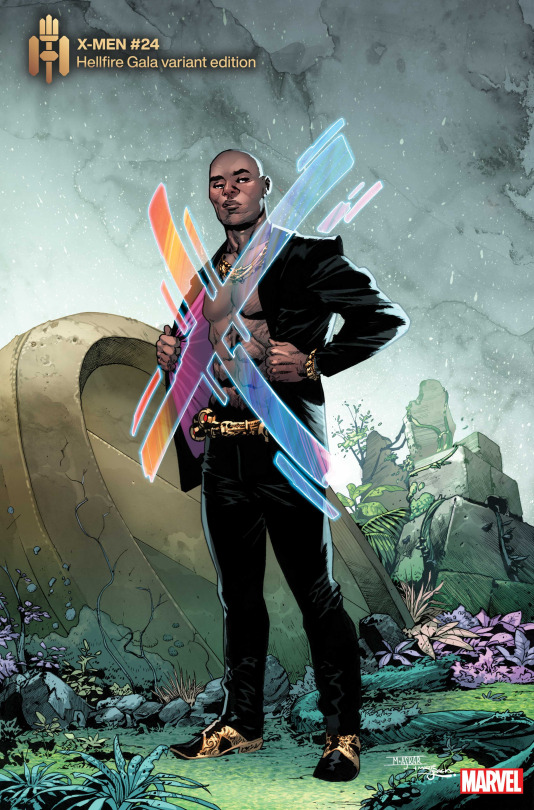
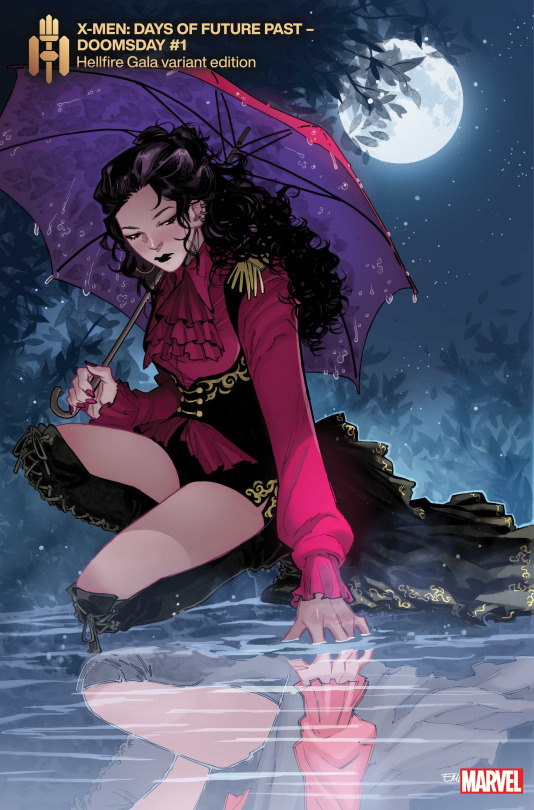
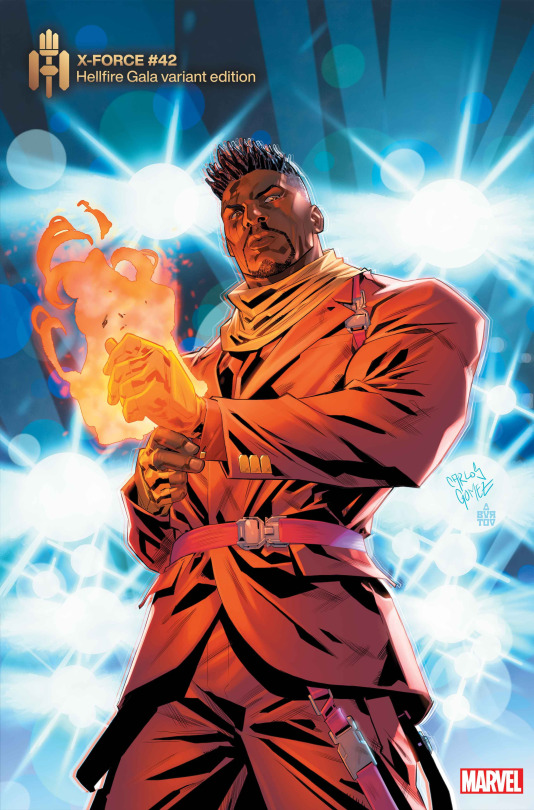



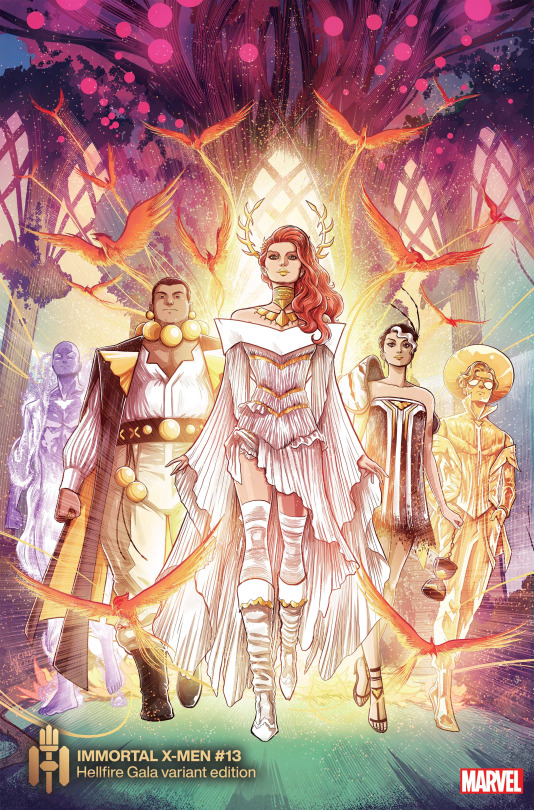







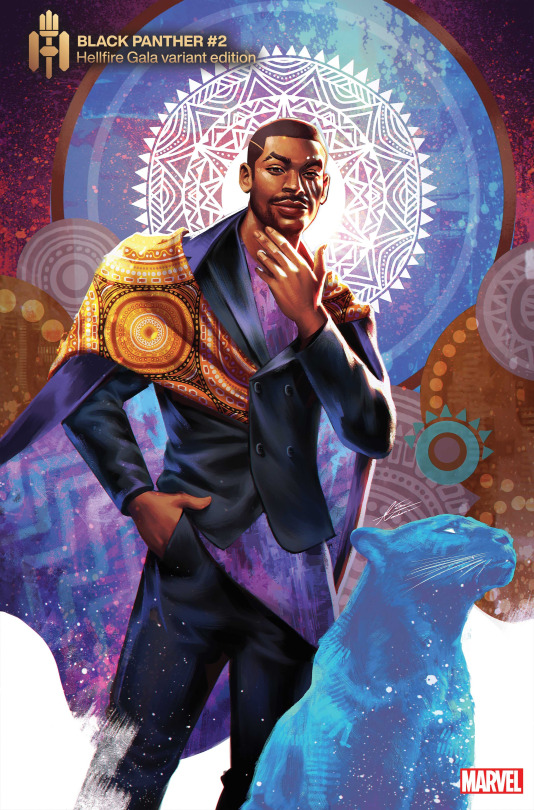
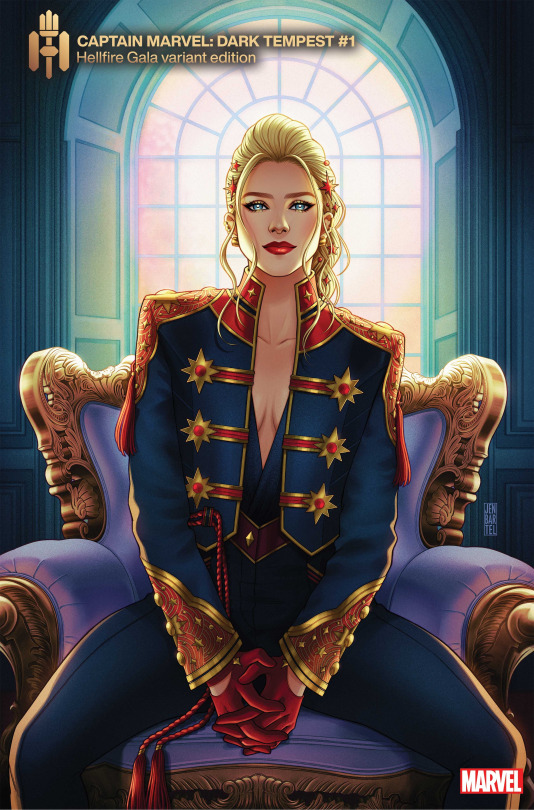
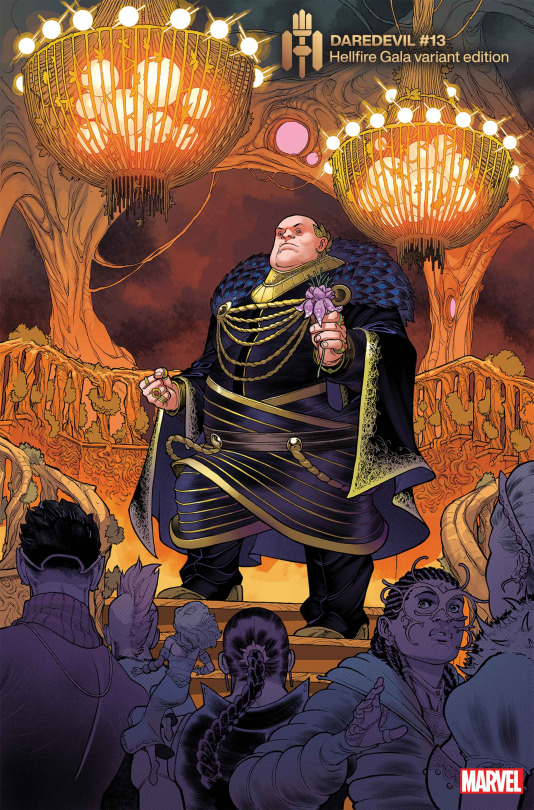
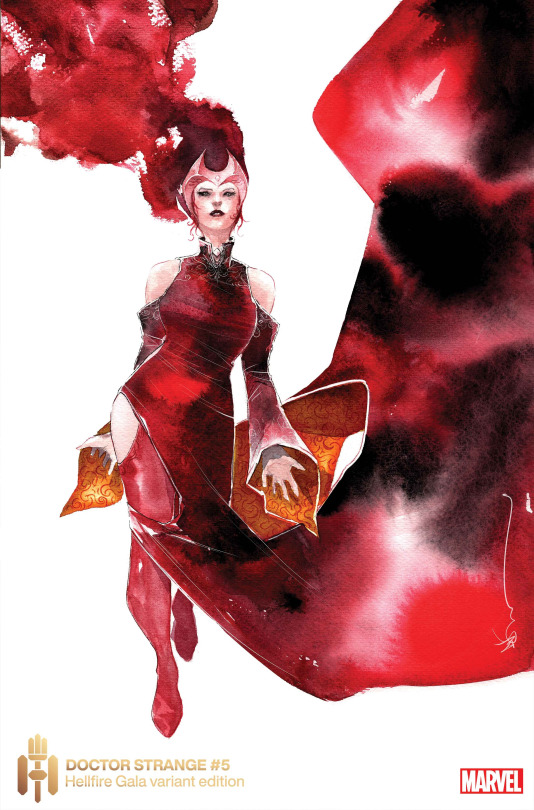
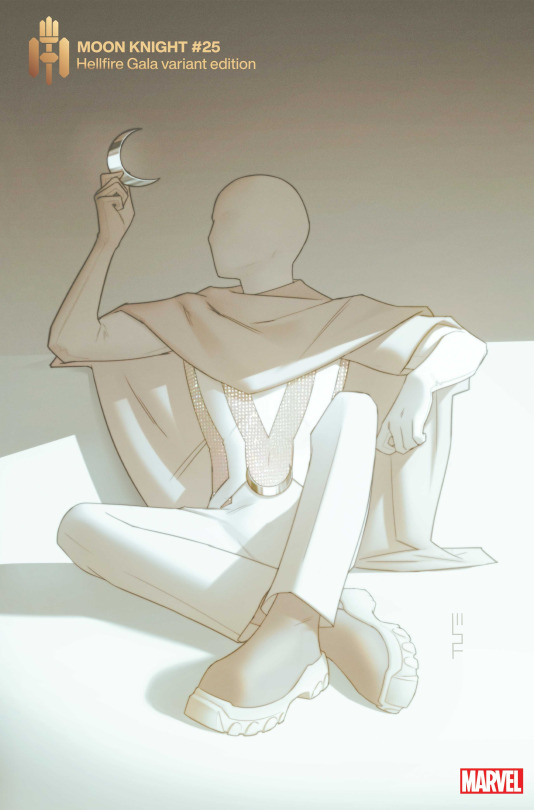
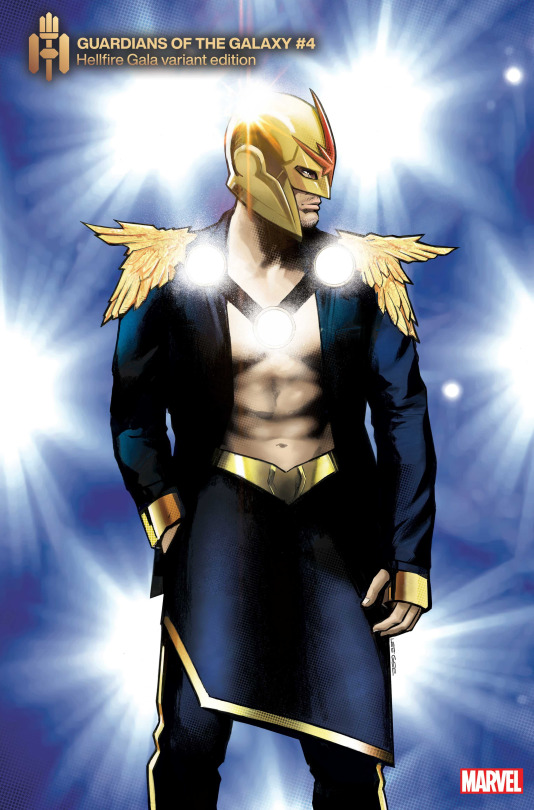
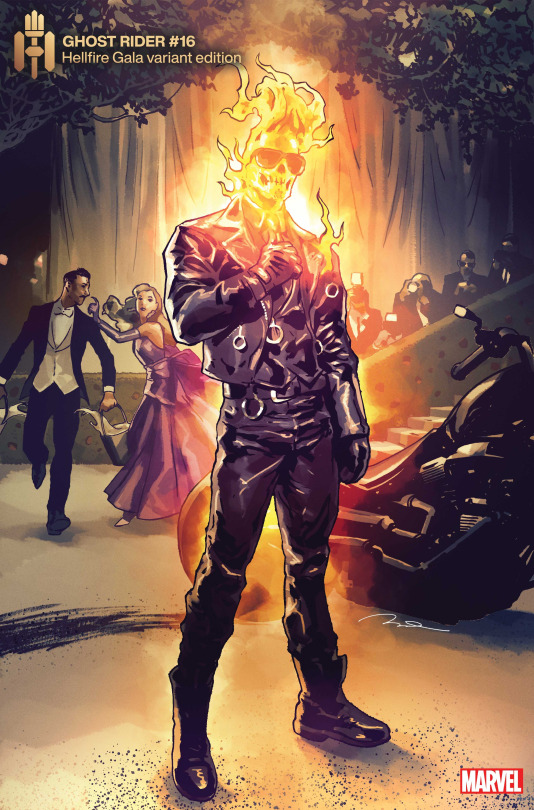
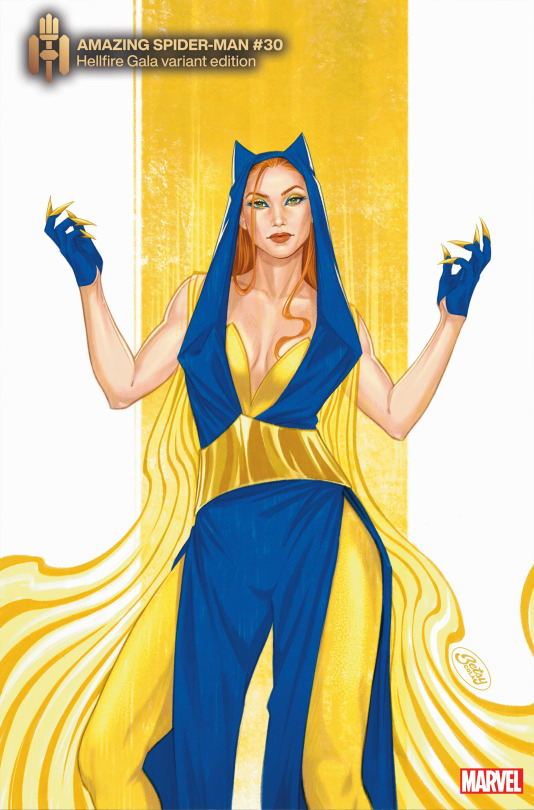

Here's the full suite of Hellfire Gala variant covers unveiled today, April 19th. I'd say the fashion designs are, on the whole, improved from last year, but they're also less fantastical and more geared towards dressed-up interpretations of existing costumes than the first Gala.
#hellfire gala#jean grey#charles xavier#laura kinney#talon#synch#kitty pryde#kate pryde#bishop#fantomex#iceman#exodus#the five#hope sumers#egg#tempus#proteus#elixir#emma frost#firestar#thor#venom#dylan brock#black cat#mary jane watson#hallow's eve#vision#black panther#captain marvel#kingpin
1K notes
·
View notes
Text
Me :(
Nora: Andrew and Neil grow old together with their silly little cats and a healthy little relationship. Andrew and Aaron take turn hosting Christmas at the others house. The foxes heal. Not perfectly but they do.
Me :)
#no but fr these books give me hope for the future#obviously not quoting her exact words#I’m sumerizing lol#aftg#all for the game#the foxhole court#andrew minyard#the foxes#neil josten#all for the gay#aftg shitpost
437 notes
·
View notes
Text
Waking up on every Wednesday maintenance morning is like Christmas to me as long as we have Idol Land... (I suddenly realize oh gosh it's Wednesday! And run out of bed to get my phone like a child running down the stairs to the Christmas tree...)
Tomorrow I am expecting Santa Jewlie to bring meee
-The opportunity to spent lots of money to gatcha for a mismatched GaarmageddonMi PPR
-New Weekly coords, probably some more in the Coord of the Now tab too
-Nino and Shion
-A new episode for monthly subscribers? Maybe??
#birthday coords aren't coming until the 17th i believe#too early for a new song probably#of course they are very welcome to add sumer night evolution or believe my dream to play with nino though.............#or better yet my way star for shion...??#but yeah really really hoping they release a garland gate SR#because Amari and Mario both got SRs soon after their gatcha coords
9 notes
·
View notes
Text
Saving all this money so I can maybe get ❄️. And get high and have some freak sex perhaps.
0 notes
Text
The most important deity you've never heard of: the 3000 years long history of Nanaya
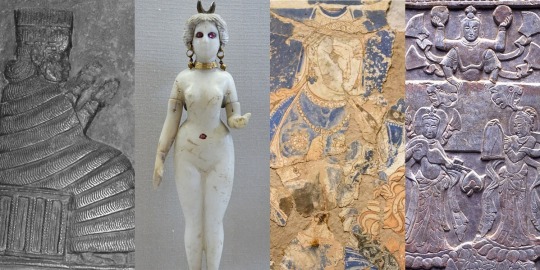
Being a major deity is not necessarily a guarantee of being remembered. Nanaya survived for longer than any other Mesopotamian deity, spread further away from her original home than any of her peers, and even briefly competed with both Buddha and Jesus for relevance. At the same time, even in scholarship she is often treated as unworthy of study. She has no popculture presence save for an atrocious, ill-informed SCP story which can’t get the most basic details right. Her claims to fame include starring in fairly explicit love poetry and appearing where nobody would expect her. Therefore, she is the ideal topic to discuss on this blog.
This is actually the longest article I published here, the culmination of over two years of research. By now, the overwhelming majority of Nanaya-related articles on wikipedia are my work, and what you can find under the cut is essentially a synthesis of what I have learned while getting there. I hope you will enjoy reading it as much as I enjoyed working on it.
Under the cut, you will learn everything there is to know about Nanaya: her origin, character, connections with other Mesopotamian deities, her role in literature, her cult centers… Since her history does not end with cuneiform, naturally the later text corpora - Aramaic, Bactrian, Sogdian and even Chinese - are discussed too. The article concludes with a short explanation why I see the study of Nanaya as crucial.
Dubious origins and scribal wordplays: from na-na to Nanaya
Long ago Samuel Noah Kramer said that “history begins in Sumer”. While the core sentiment was not wrong in many regards, in this case it might actually begin in Akkad, specifically in Gasur, close to modern Kirkuk. The oldest possible attestation of Nanaya are personal names from this city with the element na-na, dated roughly to the reign of Naram-Sin of Akkad, so to around 2250 BCE. It’s not marked in the way names of deities in personal names would usually be, but this would not be an isolated case.
The evidence is ultimately mixed. On one hand, reduplicated names like Nana are not unusual in early Akkadian sources, and -ya can plausibly be explained as a hypocoristic suffix. On the other hand, there is not much evidence for Nanaya being worshiped specifically in the far northeast of Mesopotamia in other periods. Yet another issue is that there is seemingly no root nan- in Akkadian, at least in any attested words.
The main competing proposal is that Nanaya originally arose as a hypostasis of Inanna but eventually split off through metaphorical mitosis, like a few other goddesses did, for example Annunitum. This is not entirely implausible either, but ultimately direct evidence is lacking, and when Nanaya pops up for the first time in history she is clearly a distinct goddess.
There are a few other proposals regarding Nanaya’s origin, but they are considerably weaker. Elamite has the promising term nan, “day” or “morning”, but Nanaya is entirely absent from the Old Elamite sources you’d expect to find her in if Mesopotamians imported her from the east. Therefore, very few authors adhere to this view. The hypothesis that she was an Aramaic goddess in origin does not really work chronologically, since Aramaic is not attested in the third millennium BCE at all. The less said about attempts to connect her to anything “Proto-Indo-European”, the better.
Like many other names of deities, Nanaya’s was already a subject of etymological speculation in antiquity. A late annotated version of the Weidner god list, tablet BM 62741, preserves a scribe’s speculative attempt at deriving it from the basic meaning of the sign NA, “to call”, furnished with a feminine suffix, A. Needless to say, like other such examples of scribal speculation, some of which are closer to playful word play than linguistics, it is unlikely to reflect the actual origin of the name.
Early history: Shulgi-simti, Nanaya’s earliest recorded #1 fan
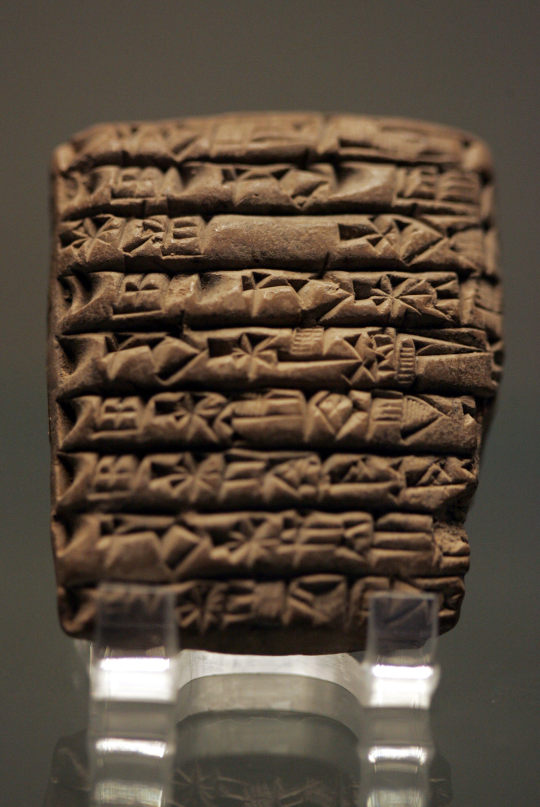
A typical Ur III administrative tablet listing offerings to various deities (wikimedia commons)
The first absolutely certain attestations of Nanaya, now firmly under her full name, have been identified in texts from the famous archive from Puzrish-Dagan, modern Drehem, dated to around 2100 BCE. Much can be written about this site, but here it will suffice to say that it was a center of the royal administration of the Third Dynasty of Ur ("Ur III") responsible for the distribution of sacrificial animals.
Nanaya appears there in a rather unique context - she was one of the deities whose cults were patronized by queen Shulgi-simti, one of the wives of Shulgi, the successor of the dynasty’s founder Ur-Namma.
We do not know much about Shulgi-simti as a person - she did not write any official inscriptions announcing her preferred foreign policy or letters to relatives or poetry or anything else that typically can be used to gain a glimpse into the personal lives of Mesopotamian royalty. We’re not really sure where she came from, though Eshnunna is often suggested as her hometown. We actually do not even know what her original name was, as it is assumed she only came to be known as Shulgi-simti after becoming a member of the royal family. Tonia Sharlach suggested that the absence of information about her personal life might indicate that she was a commoner, and that her marriage to Shulgi was not politically motivated
The one sphere of Shulgi-simti’s life which we are incredibly familiar with are her religious ventures. She evidently had an eye for minor, foreign or otherwise unusual goddesses, such as Belet-Terraban or Nanaya.
She apparently ran what Sharlach in her “biography” of her has characterized as a foundation. It was tasked with sponsoring various religious celebrations. Since Shulgi-simti seemingly had no estate to speak of, most of the relevant documents indicate she procured offerings from a variety of unexpected sources, including courtiers and other members of the royal family. The scale of her operations was tiny: while the more official religious organizations dealt with hundreds or thousands of sacrificial animals, up to fifty or even seventy thousand sheep and goats in the case of royal administration, the highest recorded number at her disposal seems to be eight oxen and fifty nine sheep.
A further peculiarity of the “foundation” is that apparently there was a huge turnover rate among the officials tasked with maintaining it. It seems nobody really lasted there for much more than four years. There are two possible explanations: either Shulgi-simti was unusually difficult to work with, or the position was not considered particularly prestigious and was, at the absolute best, viewed as a stepping stone.
While the Shulgi-simti texts are the earliest evidence for worship of Nanaya in the Ur III court, they are actually not isolated. When all the evidence from the reigns of Shulgi and his successors is summarized, it turns out that she quickly attained a prominent role, as she is among the twelve deities who received the most offerings. However, her worship was seemingly limited to Uruk (in her own sanctuary), Nippur (in the temple of Enlil, Ekur) and Ur. Granted, these were coincidentally three of the most important cities in the entire empire, so that’s a pretty solid early section of a divine resume. She chiefly appears in two types of ceremonies: these tied to the royal court, or these mostly performed by or for women. Notably, a festival involving lamentations (girrānum) was held in her honor in Uruk.
To understand Nanaya’s presence in the two aforementioned contexts, and by extension her persistence in Mesopotamian religion in later periods, we need to first look into her character.
The character of Nanaya: eroticism, kingship, and disputed astral ventures

Corona Borealis (wikimedia commons)
Nanaya’s character is reasonably well defined in primary sources, but surprisingly she was almost entirely ignored in scholarship quite recently. The first study of her which holds up to scrutiny is probably Joan Goodnick Westenholz’s article Nanaya, Lady of Mystery from 1997. The core issue is the alleged interchangeability of goddesses. From the early days of Assyriology basically up to the 1980s, Nanaya was held to be basically fully interchangeable with Inanna. This obviously put her in a tough spot. Still, over the course of the past three decades the overwhelming majority of studies came to recognize Nanaya as a distinct goddess worthy of study in her own right. You will still stumble upon the occasional “Nanaya is basically Inanna”, but now this is a minority position. Tragically it’s not extinct yet, most recently I’ve seen it in a monograph published earlier this year.
With these methodological and ideological issues out of the way, let’s actually look into Nanaya’s character, as promised by the title of this section. Her original role was that of a goddess of love. It is already attested for her at the dawn of her history, in the Ur III period. Her primary quality was described with a term rendered as ḫili in Sumerian and kuzbu in Akkadian. It can be variously translated as “charm”, “luxuriance”, “voluptuousness”, “sensuality” or “sexual attractiveness”. This characteristic was highlighted by her epithet bēlet kuzbi (“lady of kuzbu”) and by the name of her cella in the Eanna, Eḫilianna. The connection was so strong that this term appears basically in every single royal inscription praising her. She was also called bēlet râmi, “lady of love”. Nanaya’s role as a love goddess is often paired with describing her as a “joyful” or “charming” deity.
It needs to be stressed that Nanaya was by no metric the goddess of some abstract, cosmic love or anything like that. Love incantations and prayers related to love are quite common, and give us a solid glimpse into this matter. Nanaya’s range of activity in them is defined pretty directly: she deals with relationships (and by extension also with matters like one-sided crushes or arguments between spouses), romance and with strictly sexual matters. For an example of a hymn highlighting her qualifications when it comes to the last category, see here. The text is explicit, obviously.
We can go deeper, though. There is also an incantation whose incipit at first glance leaves little to imagination:

However, the translator, Giole Zisa, notes there is some debate over whether it’s actually about having sex with Nanaya or merely about invoking her (and other deities) while having sex with someone else. A distinct third possibility is that she’s not even properly invoked but that “oh, Nanaya” is simply an exclamation of excitement meant to fit the atmosphere, like a specialized version of the mainstay of modern erotica dialogue, “oh god”.
While this romantic and sexual aspect of Nanaya’s character is obviously impossible to overlook, this is not all there was to her. She was also associated with kingship, as already documented in the Ur III period. She was invoked during coronations and mourning of deceased kings. In the Old Babylonian period she was linked to investiture by rulers of newly independent Uruk.
A topic which has stirred some controversy in scholarship is Nanaya’s supposed astral role. Modern authors who try to present Nanaya as a Venus deity fall back on rather faulty reasoning, namely asserting that if Nanaya was associated with Inanna and Inanna personified Venus, clearly Nanaya did too. Of course, being associated with Inanna does not guarantee the same traits. Shaushka was associated with her so closely her name was written with the logogram representing her counterpart quite often, and lacked astral aspects altogether.
No primary sources which discuss Nanaya as a distinct, actively worshiped deity actually link her with Venus. If you stretch it you will find some tidbits like an entry in a dictionary prepared by the 10th century bishop Hasan bar Bahlul, who inexplicably asserted Nanaya was the Arabic name of the planet Venus. As you will see soon, there isn’t even a possibility that this reflected a relic of interpretatio graeca. The early Mandaean sources, many of which were written when at least remnants of ancient Mesopotamian religion were still extant, also do not link Nanaya with Venus. Despite at best ambivalent attitude towards Mesopotamian deities, they show remarkable attention to detail when it comes to listing their cult centers, and on top of that Mesopotamian astronomy had a considerable impact on Mandaeism, so there is no reason not to prioritize them, as far as I am concerned.
As far as the ancient Mesopotamian sources themselves go, the only astral object with a direct connection to Nanaya was Corona Borealis (BAL.TÉŠ.A, “Dignity”), as attested in the astronomical compendium MUL.APIN. Note that this is a work which assigns astral counterparts to virtually any deity possible, though, and there is no indication this was a major part of Nanaya’s character. Save for this single instance, she is entirely absent from astronomical texts.
A further astral possibility is that Nanaya was associated with the moon. The earliest evidence is highly ambiguous: in the Ur III period festivals held in her honor might have been tied to phases of the moon, while in the Old Babylonian period a sanctuary dedicated to her located in Larsa was known under the ceremonial name Eitida, “house of the month”. A poem in which looking at her is compared to looking at the moon is also known. That’s not all, though. Starting with the Old Babylonian period, she could also be compared with the sun. Possibly such comparisons were meant to present her as an astral deity, without necessarily identifying her with a specific astral body. Michael P. Streck and Nathan Wasserman suggest that it might be optimal to simply refer to her as a “luminous” deity in this context. However, as you will see later it nonetheless does seem she eventually came to be firmly associated both with the sun and the moon.
Last but not least, Nanaya occasionally displayed warlike traits. It’s hardly major in her case, and if you tried hard enough you could turn any deity into a war deity depending on your political goals, though. I’d also place the incantation which casts her as one of the deities responsible for keeping the demon Lamashtu at bay here.
Nanaya in art
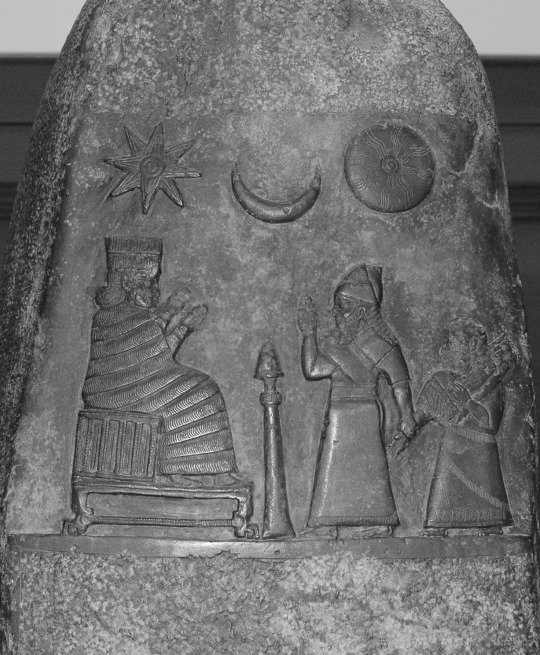
The oldest known depiction of Nanaya (wikimedia commons)
While Nanaya’s roles are pretty well defined, there surprisingly isn’t much to say about her iconography in Mesopotamian art.The oldest certain surviving depiction of her is rather indistinct: she’s wearing a tall headdress and a flounced robe. It dates to the late Kassite period (so roughly to 1200 BCE), and shows her alongside king Meli-Shipak (or maybe Meli-Shihu, reading remains uncertain) and his daughter Hunnubat-Nanaya. Nanaya is apparently invoked to guarantee that the prebend granted to the princess will be under divine protection. This is not really some unique prerogative of hers, perhaps she was just the most appropriate choice because Hunnubat-Nanaya’s name obviously reflects devotion to her.
The relief discussed above is actually the only depiction of Nanaya identified with certainty from before the Hellenistic period, surprisingly. We know that statues representing her existed, and it is hard to imagine that a popular, commonly worshiped deity was not depicted on objects like terracotta decorations and cylinder seals, but even if some of these were discovered, there’s no way to identify them with certainty. This is not unusual though, and ultimately there aren’t many Mesopotamian deities who can be identified in art without any ambiguity.
Nanaya in literature
As I highlighted in the section dealing with Nanaya’s character, she is reasonably well attested in love poetry. However, this is not the only genre in which she played a role.
A true testament to Nanaya’s prominence is a bilingual (Sumero-Akkadian) hymn composed in her honor in the first millennium BCE. It is written in the first person, and presents various other goddesses as her alternate identities. It is hardly unique, and similar compositions dedicated to Ishtar (Inanna), Gula, Ninurta and Marduk are also known.
Each strophe describes a different deity and location, but ends with Nanaya reasserting her actual identity with the words “still I am Nanaya”. Among the claimed identities included are both major goddesses in their own right (Inanna plus closely associated Annunitum and Ishara, Gula, Bau, Ninlil), goddesses relevant due to their spousal roles first and foremost (Damkina, Shala, Mammitum etc) and some truly unexpected, picks, the notoriously elusive personified rainbow Manzat being the prime example. Most of them had very little in common with Nanaya, so this might be less an attempt at syncretism, and more an elevation of her position through comparisons to those of other goddesses.
An additional possible literary curiosity is a poorly preserved myth which Wilfred G. Lambert referred to as “The murder of Anshar”. He argues that Nanaya is one of the two deities responsible for the eponymous act. I don't quite follow the logic, though: the goddess is actually named Ninamakalamma (“Lady mother of the land”), and her sole connection with Nanaya is that they occur in sequence in the unique god list from Sultantepe. Lambert saw this as a possible indication they are identical. There are no other attestations of this name, but ama kalamma does occur as an epithet of various goddesses, most notably Ninshubur. Given her juxtaposition with Nanaya in the Weidner god list - more on that later - wouldn’t it make more sense to assume it’s her? Due to obscurity of the text as far as I am aware nobody has questioned Lambert’s tentative proposal yet, though.
There isn’t much to say about the plot: Anshar, literally “whole heaven”, the father of Anu, presumably gets overthrown and might be subsequently killed. Something that needs to be stressed here to avoid misinterpretation: primordial deities such as Anshar were borderline irrelevant, and weren't really worshiped. They exist to fade away in myths and to be speculated about in elaborate lexical texts. There was no deposed cult of Anshar. Same goes for all the Tiamats and Enmesharras and so on.
Inanna and beyond: Nanaya and friends in Mesopotamian sources
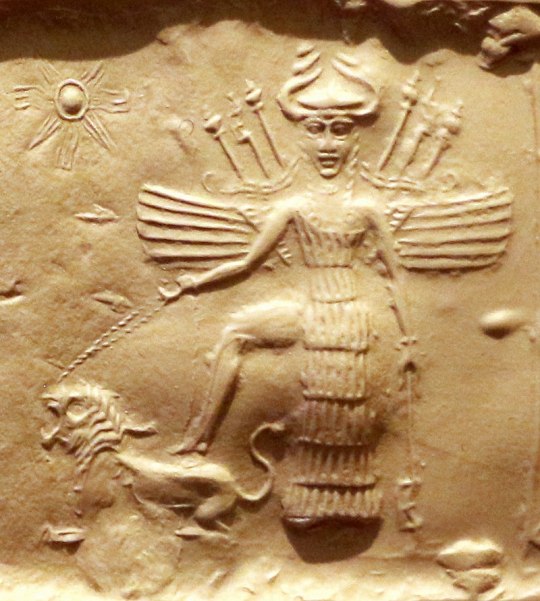
Inanna on a cylinder seal from the second half of the third millennium BCE (wikimedia commons)
Of course, Nanaya’s single most important connection was that to Inanna, no matter if we are to accept the view that she was effectively a hypostasis gone rogue or not. The relationship between them could be represented in many different ways. Quite commonly she was understood as a courtier or protegee of Inanna. A hymn from the reign of Ishbi-Erra calls her the “ornament of Eanna” (Inanna’s main temple in Uruk) and states she was appointed by Inanna to her position. References to Inanna as Nanaya’s mother are also known, though they are rare, and might be metaphorical. To my best knowledge nothing changed since Olga Drewnowska-Rymarz’s monograph, in which she notes she only found three examples of texts preserving this tradition. I would personally abstain from trying to read too deep into it, given this scarcity.
Other traditions regarding Nanaya’s parentage are better attested. In multiple cases, she “borrows” Inanna’s conventional genealogy, and as a result is addressed as a daughter of Sin (Nanna), the moon god. However, she was never addressed as Inanna’s sister: it seems that in cases where Sin and Nanaya are connected, she effectively “usurps” Inanna’s own status as his daughter (and as the sister of Shamash, while at it). Alternatively, she could be viewed as a daughter of Anu.
Finally, there is a peculiar tradition which was the default in laments: in this case, Nanaya was described as a daughter of Urash. The name in this context does not refer to the wife of Anu, though. The deity meant is instead a small time farmer god from Dilbat. To my best knowledge no sources place Nanaya in the proximity of other members of Urash’s family, though some do specify she was his firstborn daughter. To my best knowledge Urash had at least two other children, Lagamal (“no mercy”, an underworld deity whose gender is a matter of debate) and Ipte-bitam (“he opened the house”, as you can probably guess a divine doorkeeper). Nanaya’s mother by extension would presumably be Urash’s wife Ninegal, the tutelary goddess of royal palaces. There is actually a ritual text listing these three together.
In the Weidner god list Nanaya appears after Ninshubur. Sadly, I found no evidence for a direct association between these two. For what it’s worth, they did share a highly specific role, that of a deity responsible for ordering around lamma. This term referred to a class of minor deities who can be understood as analogous to “guardian angels” in contemporary Christianity, except places and even deities had their own lamma too, not just people. Lamma can also be understood at once as a class of distinct minor deities, as the given name of individual members of it, and as a title of major deities. In an inscription of Gudea the main members of the official pantheon are addressed as “lamma of all nations”, by far one of my favorite collective terms of deities in Mesopotamian literature.
A second important aspect of the Weidner god list is placing Nanaya right in front of Bizilla. The two also appear side by side in some offering lists and in the astronomical compendium MUL.APIN, where they are curiously listed as members of the court of Enlil. It seems that like Nanaya, she was a goddess of love, which is presumably reflected by her name. It has been variously translated as “pleasing”, “loving” or as a derivative of the verb “to strip”. An argument can be made that Bizilla was to Nanaya what Nanaya was to Inanna. However, she also had a few roles of her own. Most notably, she was regarded as the sukkal of Ninlil. She may or may not also have had some sort of connection to Nungal, the goddess of prisons, though it remains a matter of debate if it’s really her or yet another, accidentally similarly named, goddess.

An indistinct Hurro-Hittite depiction of Ishara from the Yazilikaya sanctuary (wikimedia commons)
In love incantations, Nanaya belonged to an informal group which also included Inanna, Ishara, Kanisurra and Gazbaba. I do not think Inanna’s presence needs to be explained. Ishara had an independent connection with Inanna and was a multi-purpose deity to put it very lightly; in the realm of love she was particularly strongly connected with weddings and wedding nights. Kanisurra and Gazbaba warrant a bit more discussion, because they are arguably Nanaya’s supporting cast first and foremost.
Gazbaba is, at the core, seemingly simply the personification of kuzbu. Her name had pretty inconsistent orthography, and variants such as Kazba or Gazbaya can be found in primary sources too. The last of them pretty clearly reflects an attempt at making her name resemble Nanaya’s. Not much can be said about her individual character beyond the fact she was doubtlessly related to love and/or sex. She is described as the “grinning one” in an incantation which might be a sexual allusion too, seeing as such expressions are a mainstay of Akkadian erotic poetry.
Kanisurra would probably win the award for the fakest sounding Mesopotamian goddess, if such a competition existed. Her name most likely originated as a designation of the gate of the underworld, ganzer. Her default epithet was “lady of the witches” (bēlet kaššāpāti). And on top of that, like Nanaya and Gazbaba she was associated with sex. She certainly sounds more like a contemporary edgy oc of the Enoby Dimentia Raven Way variety than a bronze age goddess - and yet, she is completely genuine.
It is commonly argued Kanisurra and Gazbaba were regarded as Nanaya’s daughters, but there is actually no direct evidence for this. In the only text where their relation to Nanaya is clearly defined they are described as her hairdressers, rather than children.
While in some cases the love goddesses appear in love incantations in company of each other almost as if they were some sort of disastrous polycule, occasionally Nanaya is accompanied in them by an anonymous spouse. Together they occur in parallel with Inanna and Dumuzi and Ishara and Almanu, apparently a (accidental?) deification of a term referring to someone without family obligations.
There is only one Old Babylonian source which actually assigns a specific identity to Nanaya’s spouse, a hymn dedicated to king Abi-eshuh of Babylon. An otherwise largely unknown god Muati (I patched up his wiki article just for the sake of this blog post) plays this role here.
The text presents a curious case of reversal of gender roles: Muati is asked to intercede with Nanaya on behalf of petitioners. Usually this was the role of the wife - the best known case is Aya, the wife of Shamash, who is implored to do just that by Ninsun in the standard edition of the Epic of Gilgamesh. It’s also attested for goddesses such as Laz, Shala, Ninegal or Ninmug… and in the case of Inanna, for Ninshubur.

A Neo-Assyrian statue of Nabu on display in the Iraq Museum (wikimedia commons)
Marten Stol seems to treat Muati and Nabu as virtually the same deity, and on this basis states that Nanaya was already associated with the latter in the Old Babylonian period, but this seems to be a minority position. Other authors pretty consistently assume that Muati was a distinct deity at some point “absorbed” by Nabu.
The oldest example of pairing Nanaya with Nabu I am aware of is an inscription dated to the reign of Marduk-apla-iddina I, so roughly to the first half of the twelfth century BCE. The rise of this tradition in the first millennium BCE was less theological and more political. With Babylon once again emerging as a preeminent power, local theologies were supposed to be subordinated to the one followed in the dominant city. Which, at the time, was focused on Nabu, Marduk and Zarpanit. Worth noting that Nabu also had a spouse before, Tashmetum (“reconciliation”). In the long run she was more or less ousted by Nanaya from some locations, though she retained popularity in the north, in Assyria. She is not exactly the most thrilling deity to discuss. I will confess I do not find the developments tied to Nanaya and Nabu to be particularly interesting to cover, but in the long run they might have resulted in Nanaya acquiring probably the single most interesting “supporting cast member” she did not share with Inanna, so we’ll come back to this later.
Save for Bizilla, Nanaya generally was not provided with “equivalents” in god lists. I am only aware of one exception, and it’s a very recent discovery. Last year the first ever Akkadian-Amorite bilingual lists were published. This is obviously a breakthrough discovery, as before Amorite was largely known just from personal names despite being a vernacular language over much of the region in the bronze age, but only one line is ultimately of note here. In a section of one of the lists dealing with deities, Nanaya’s Amorite counterpart is said to be Pidray. This goddess is otherwise almost exclusively known from Ugarit. This of course fits very well with the new evidence: recent research generally stresses that Ugarit was quintessentially an Amorite city (the ruling house even claimed descent from mythical Ditanu, who is best known from the grandiose fictional genealogies of Shamshi-Adad I and the First Dynasty of Babylon).
Sadly, we do not know how the inhabitants of Ugarit viewed Nanaya. A trilingual version of the Weidner list, with the original version furnished with columns listing Ugaritic and Hurrian counterparts of each deity, was in circulation, but the available copies are too heavily damaged to restore it fully. And to make things worse, much of it seems to boil down to scribal wordplay and there is no guarantee all of the correspondences are motivated theologically. For instance, the minor Mesopotamian goddess Imzuanna is presented as the counterpart of Ugaritic weather god Baal because her name contains a sign used as a shortened logographic writing of the latter. An even funnier case is the awkward attempt at making it clear the Ugaritic sun deity Shapash, who was female, is not a lesbian… by making Aya male. Just astonishing, really.
The worship of Nanaya
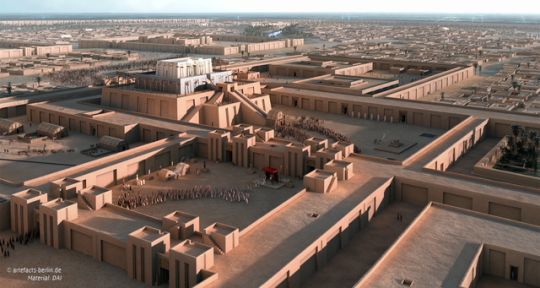
A speculative reconstruction of Ur III Uruk with the Eanna temple visible in the center (Artefacts — Scientific Illustration & Archaeological Reconstruction; reproduced here for educational purposes only, as permitted)
Rather fittingly, as a deity associated with Inanna, Nanaya was worshiped chiefly in Uruk. She is also reasonably well attested in the inscriptions of the short-lived local dynasty which regained independence near the end of the period of domination of Larsa over Lower Mesopotamia. A priest named after her, a certain Iddin-Nanaya, for a time served as the administrator of her temple, the Enmeurur, “house which gathers all the me,” me being a difficult to translate term, something like “divine powers”. The acquisition of new me is a common topic in Mesopotamian literature, and in compositions focused on Inanna in particular, so it should not be surprising to anyone that her peculiar double seemingly had similar interests.
In addition to Uruk, as well as Nippur and Ur, after the Ur III period Nanaya spread to multiple other cities, including Isin, Mari, Babylon and Kish. However, she is probably by far the best attested in Larsa, where she rose to the rank of one of the main deities, next to Utu, Inanna, Ishkur and Nergal. She had her own temple, the Eshahulla, “house of a happy heart”. In local tradition Inanna got to keep her role as an “universal” major goddess and her military prerogatives, but Nanaya overtook the role of a goddess of love almost fully. Inanna’s astral aspect was also locally downplayed, since Venus was instead represented in the local pantheon by closely associated, but firmly distinct, Ninsianna. This deity warrants some more discussion in the future just due to having a solid claim to being one of the first genderfluid literary figures in history, but due to space constraints this cannot be covered in detail here.
A later inscription from the same city differentiates between Nanaya and Inanna by giving them different epithets: Nanaya is the “queen of Uruk and Eanna” (effectively usurping Nanaya’s role) while Inanna is the “queen of Nippur” (that’s actually a well documented hypostasis of her, not to be confused with the unrelated “lady of Nippur”).
Uruk was temporarily abandoned in the late Old Babylonian period, but that did not end Nanaya’s career. Like Inanna, she came to be temporarily relocated to Kish. It has been suggested that a reference to her residence in “Kiššina” in a Hurro-Hittite literary text, the Tale of Appu, reflects her temporary stay there.
The next centuries of Nanaya are difficult to reconstruct due to scarce evidence, but it is clear she continued to be worshiped in Uruk. By the Neo-Babylonian period she was recognized as a member of an informal pentad of the main deities of the city, next to Inanna, Urkayitu, Usur-amassu and Beltu-sa-Resh. Two of them warrant no further discussion: Urkayitu was most likely a personification of the city, and Beltu-sa-Resh despite her position is still a mystery to researchers.
Usur-amassu, on the contrary, is herself a fascinating topic. First attestations of this deity, who was seemingly associated with law and justice (a pretty standard concern), come back to the Old Babylonian period. At this point, Usur-amassu was clearly male, which is reflected by the name. He appears in the god list An = Anum as a son of the weather deity couple par excellence, Adad (Ishkur) and Shala. However, by the early first millennium BCE Usur-amassu instead came to be regarded as female - without losing the connection to her parents. She did however gain a connection to Inanna, Nanaya and Kanisurra, which she lacked earlier. How come remains unknown. Most curiously her name was not modified to reflect her new gender, though she could be provided with a determinative indicating it. This recalls the case of Lagamal in the kingdom of Mari some 800 years earlier.
The end of the beginning: Nanaya under Achaemenids and Seleucids
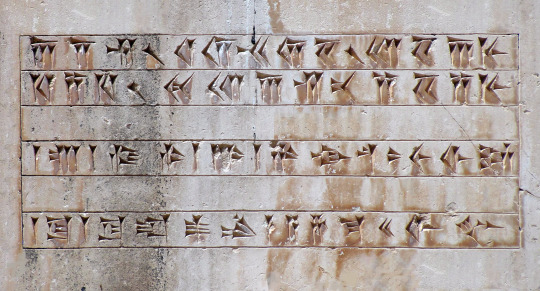
Trilingual (Persian, Elamite and Akkadian) inscription of the first Achamenid ruler of Mesopotamia, Cyrus (wikimedia commons)
After the fall of the Neo-Babylonian Empire Mesopotamia ended up under Achaemenid control, which in turn was replaced by the Seleucids. Nanaya flourished through both of these periods. In particular, she attained considerable popularity among Arameans. While they almost definitely first encountered her in Uruk, she quickly came to be venerated by them in many distant locations, like Palmyra, Hatra and Dura Europos in Syria. She even appears in a single Achaemenid Aramaic papyrus discovered in Elephantine in Egypt. It indicates that she was worshiped there by a community which originated in Rash, an area east to the Tigris. As a curiosity it’s worth mentioning the same source is one of the only attestations of Pidray from outside Ugarit. I do not think this has anything to do with the recently discovered connection between her and Nanaya… but you may never know.
Under the Seleucids, Nanaya went through a particularly puzzling process of partial syncretism. Through interpretatio graeca she was identified with… Artemis. How did this work? The key to understanding this is the fact Seleucids actually had a somewhat limited interest in local deities. All that was necessary was to find relatively major members of the local pantheon who could roughly correspond to the tutelary deities of their dynasty: Zeus, Apollo and Artemis. Zeus found an obvious counterpart in Marduk (even though Marduk was hardly a weather god). Since Nabu was Marduk’s son, he got to be Apollo. And since Nanaya was the most major goddess connected to Nabu, she got to be Artemis. It really doesn’t go deeper than that.
For what it’s worth, despite the clear difference in character this newfound association did impact Nanaya in at least one way: she started to be depicted with attributes borrowed from Artemis, namely a bow and a crescent. Or perhaps these attributes were already associated with her, but came to the forefront because of the new role. The Artemis-like image of Nanaya as an archer is attested on coins, especially in Susa, yet another city where she attained considerable popularity.
Leaving Mesopotamia: Nanaya and the death of cuneiform
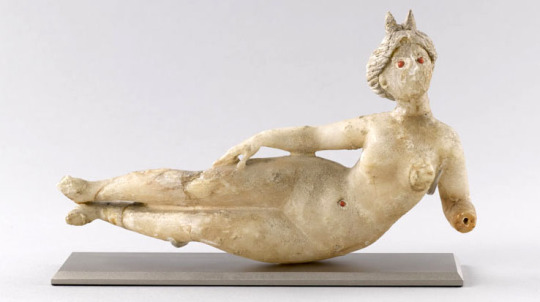
A Parthian statue of Nanaya with a crescent diadem (Louvre; reproduced here for educational purposes only. Identification follows Andrea Sinclair's proposal)
The Seleucid dynasty was eventually replaced by the Parthians. This period is often considered a symbolic end of ancient Mesopotamian religion in the strict sense. Traditional religious institutions were already slowly collapsing in Achaemenid and Seleucid times as the new dynasties had limited interest in royal patronage. Additionally, cuneiform fell out of use, and by the end of the first half of the first millennium CE the art of reading and writing it was entirely lost. This process did not happen equally quickly everywhere, obviously, and some deities fared better than others in the transitional period before the rise of Christianity and Islam as the dominant religions across the region. Nanaya was definitely one of them, at least for a time.
In Parthian art Nanaya might have developed a distinct iconography: it has been argued she was portrayed as a nude figure wearing only some jewelry (including what appears to be a navel piercing and a diadem with a crescent. The best known example is probably this standing figure, one of my all time favorite works of Mesopotamian art:

Parthian Nanaya (wikimedia commons; identification courtesy of the Louvre website and J. G. Westenholz)
For years Wikipedia had this statue mislabeled as “Astarte” which makes little sense considering it comes from a necropolis near Babylon. There was also a viral horny tweet which labeled it as “Asherah” a few months ago (I won’t link it but I will point out in addition to getting the name wrong op also severely underestimated the size). This is obviously even worse nonsense both on spatial and temporal grounds. Even if the biblical Asherah was ever an actual deity like Ugaritic Athirat and Mesopotamian Ashratum, it is highly dubious she would still be worshiped by the time this statue was made. It’s not even certain she ever was a deity, though. Cognate of a theonym is not automatically a theonym itself, and the Ugaritic texts and the Bible, even if they share some topoi, are separated by centuries and a considerable distance. This is not an Asherah post though, so if this is a topic which interests you I recommend downloading Steve A. Wiggins’ excellent monograph A Reassessment of Asherah: With Further Considerations of the Goddess.
The last evidence for the worship of Nanaya in Mesopotamia is a Mandaean spell from Nippur, dated to the fifth or sixth century CE. However, at this point Nanaya must have been a very faint memory around these parts, since the figure designated by this name is evidently male in this formula. That was not the end of her career, though. The system of beliefs she originated and thrived in was on its way out, but there were new frontiers to explore.
A small disgression is in order here: be INCREDIBLY wary of claims about the survival of Mesopotamian tradition in Mesopotamia itself past the early middle ages. Most if not all of these come from the writing of Simo Parpola, who is a 19th century style hyperdiffusionist driven by personal religious beliefs based on gnostic christianity, which he believes was based on Neo-Assyrian state religion, which he misinterprets as monotheism, or rather proto-christianity specifically (I wish I was making this up). I personally do not think a person like that should be tolerated in serious academia, but for some incomprehensible reason that isn’t the case.
New frontiers: Nanaya in Bactria
The key to Nanaya’s extraordinarily long survival wasn’t the dedication to her in Mesopotamia, surprisingly. It was instead her introduction to Bactria, a historical area in Central Asia roughly corresponding to parts of modern Afghanistan, Tajikistan and Uzbekistan. The early history of this area is still poorly known, though it is known that it was one of the “cradles of civilization” not unlike Mesopotamia, the Indus Valley or Mesoamerica. The so-called “Oxus civilization” or “Bactria-Margiana Archaeological Complex” flourished around 2500-1950 BCE (so roughly contemporarily with the Akkadian and Ur III empires in Mesopotamia). It left behind no written records, but their art and architecture are highly distinctive and reflect great social complexity.
I sadly can’t spent much time discussing them here though, as they are completely irrelevant to the history of Nanaya (there is a theory that she was already introduced to the east when BMAC was extant but it is incredibly implausible), so I will limit myself to showing you my favorite related work of art, the “Bactrian princess”:

Photo courtesy of Louvre Abu Dhabi, reproduced here for educational purposes only.
By late antiquity, which is the period we are concerned with here, BMAC was long gone, and most of the inhabitants of Bactria spoke Bactrian, an extinct Iranian language. How exactly they were related to their BMAC forerunners is uncertain. Their religious beliefs can be compared to Zoroastrianism, or rather with its less formalized forerunners followed by most speakers of Iranian languages before the rise of Zoroaster. However, there were many local peculiarities. For example, the main deity was the personified river Oxus, not Ahura Mazda. Whether this was a relic of BMAC religion is impossible to tell.We do not know exactly when the eastward transfer of Nanaya to Bactria happened. The first clear evidence for her presence in central Asia comes from the late first century BCE, from the coins of local rulers, Sapadbizes and Agesiles. It is possible that her depictions on coinage of Mesopotamian and Persian rulers facilitated her spread. Of course, it’s also important to remember that the Aramaic script and language spread far to the east in the Achaemenid period already, and that many of the now extinct Central Asian scripts were derived from it (Bactrian was written with the Greek script, though). Doubtlessly many now lost Aramaic texts were transferred to the east.
There’s an emerging view that for unclear reasons, under the Achaemenids Mesopotamian culture as a whole had unparalleled impact on Bactria. The key piece of evidence are Bactrian temples, which often resemble Mesopotamian ones. Therefore, perhaps we should be wondering not why Nanaya spread from Mesopotamia to Central Asia, but rather why there were no other deities who did, for the most part. That is sadly a question I cannot answer. Something about Nanaya simply made her uniquely appealing to many groups at once.
While much about the early history of Nanaya in Central Asia is a mystery, it is evident that with time she ceased to be viewed as a foreign deity. For the inhabitants of Bactria she wasn’t any less “authentically Iranian” than the personified Oxus or their versions of the conventional yazatas like Sraosha. Frequently arguments are made that Nanaya’s widespread adoption and popularity could only be the result of identification between her and another deity.Anahita in particular is commonly held to be a candidate. However, as stressed by recent studies there’s actually no evidence for this.
What is true is that Anahita is notably missing from the eastern Iranian sources, despite being prominent in the west from the reign of the Achaemenid emperor Artaxerxes II onward. However, it is clear that not all yazatas were equally popular in each area - pantheons will inevitably be localized in each culture. Furthermore, Anahita’s character has very little in common with Nanaya save for gender. Whether we are discussing her early not quite Zoroastrian form the Achaemenid public was familiar with or the contemporary yazata still relevant in modern Zoroastrianism, the connection to water is the most important feature of her. Nanaya didn’t have such a role in any culture.
Recently some authors suggested a much more obvious explanation for Anahita’s absence from the eastern Iranian pantheon(s). As I said, eastern Iranian communities venerated the river Oxus as a deity (or as a yazata, if you will). He was the water god par excellence, and in Bactria also the king of the gods. It is therefore quite possible that Anahita, despite royal backing from the west, simply couldn’t compete with him. Their roles overlapped more than the roles of Anahita and Nanaya. I am repeating myself but the notion of interchangeability of goddesses really needs to be distrusted almost automatically, no matter how entrenched it wouldn’t be. While we’re at it, the notion of alleged interchangeability between Anahita and Ishtar is also highly dubious, but that’s a topic for another time.

Nana (Nanaya) on a coin of Kanishka (wikimedia commons)
Nanaya experienced a period of almost unparalleled prosperity with the rise of the Kushan dynasty in Bactria. The Kushans were one of the groups which following Chinese sources are referred to as Yuezhi. They probably did not speak any Iranian language originally, and their origin is a matter of debate. However, they came to rule over a kingdom which consisted largely of areas inhabited by speakers of various Iranian languages, chiefly Bactrian. Their pantheon, documented in royal inscriptions and on coinage, was an eerie combination of mainstays of Iranian beliefs like Sraosha and Mithra and some unique figures, like Oesho, who was seemingly the reflection of Hindu Shiva. Obviously, Nanaya was there too, typically under the shortened name Nana.
The most famous Kushan ruler, emperor Kanishka, in his inscription from Rabatak states that kingship was bestowed upon him by “Nana and all the gods”. However, we do not know if the rank assigned to her indicates she was the head of the dynastic pantheon, the local pantheon in the surrounding area, or if she was just the favorite deity of Kanishka. Same goes for the rank of numerous other deities mentioned in the rest of the inscription. Her apparent popularity during Kanishka’s reign and beyond indicates her role should not be downplayed, though.
The coins of Kanishka and other Bactrian art indicate that a new image of Nanaya developed in Central Asia. The Artemis-like portrayals typical for Hellenistic times continue to appear, but she also started to be depicted on the back of a lion. There is only one possible example of such an image from the west, a fragmentary relief from Susa, and it’s roughly contemporary with the depictions from Bactria. While it is not impossible Nanaya originally adopted the lion association from one of her Mesopotamian peers, it is not certain how exactly this specific type of depictions originally developed, and there is a case to be made that it owed more to the Hellenistic diffusion of iconography of deities such as Cybele and Dionysus, who were often depicted riding on the back of large felines.
The lunar symbols are well attested in the Kushan art of Nanaya too. Most commonly, she’s depicted wearing a diadem with a crescent. However, in a single case the symbol is placed behind her back. This is an iconographic type which was mostly associated with Selene at first, but in the east it was adopted for Mah, the Iranian personification of the moon. I’d hazard a guess that’s where Nanaya borrowed it from - more on that later.
The worship of Nanaya survived the fall of the Kushan dynasty, and might have continued in Bactria as late as in the eighth century. However, the evidence is relatively scarce, especially compared with yet another area where she was introduced in the meanwhile.
Nanaya in Sogdia: new home and new friends
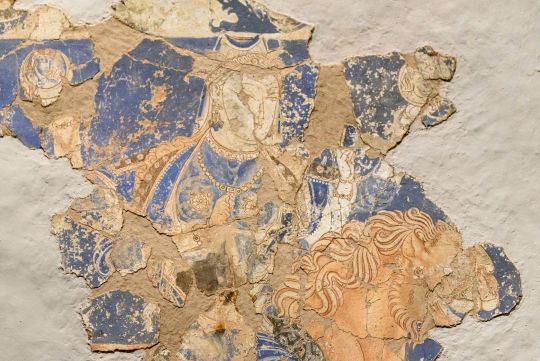
A Sogdian depiction of Nanaya from Bunjikat (wikimedia commons)
Presumably from Bactria, Nanaya was eventually introduced to Sogdia, its northern neighbor. I think it’s safe to say this area effectively became her new home for the rest of her history.
Like Bactrians, the Sogdians also spoke an eastern Iranian language, Sogdian. It has a direct modern descendant, Yaghnobi, spoken by a small minority in Tajikistan. The religions Sogdians adhered to is often described as a form of Zoroastrianism, especially in older sources, but it would appear that Ahura Mazda was not exactly the most popular deity. Their pantheon was seemingly actually headed by Nanaya. Or, at the very least, the version of it typical for Samarkand and Panijkant, since there’s a solid case to be made for local variety in the individual city-states which made up Sogdia. It seems that much like Mesopotamians and Greeks centuries before them, Sogdians associated specific deities with specific cities, and not every settlement necessarily venerated each deity equally (or at all). Nanaya's remarkable popularity is reflected by the fact the name Nanaivandak, "servant of Nanaya", is one of the most common Sogdian names in general.
It is agreed that among the Sogdians Panjikant was regarded as Nanaya’s cult center. She was referred to as “lady” of this city. At one point, her temple located there was responsible for minting the local currency. By the eighth century, coins minted there were adorned with dedications to her - something unparalleled in Sogdian culture, as the rest of coinage was firmly secular. This might have been an attempt at reasserting Sogdian religious identity in the wake of the arrival of Islam in Central Asia.
Sogdians adopted the Kushan iconography of Nanaya, though only the lion-mounted version. The connection between her and this animal was incredibly strong in Sogdian art, with no other deity being portrayed on a similar mount. There were also innovations - Nanaya came to be frequently portrayed with four arms. This reflects the spread of Buddhism through central Asia, which brought new artistic conventions from India. While the crescent symbol can still be found on her headwear, she was also portrayed holding representations of the moon and the sun in two of her hands.
Sometimes the solar disc and lunar orb are decorated with faces, which has been argued to be evidence that Nanaya effectively took over the domains of Mah and Mithra, who would be the expected divine identities of these two astral bodies. She might have been understood as controlling the passage of night and day. It has also been pointed out that this new iconographic type is the natural end point of the evolution of her astral role.
Curiously, while no such a function is attested for Nanaya in Bactria, in Sogdia she could be sometimes regarded as a warlike deity. This is presumably reflected in a painting showing her and an unidentified charioteer fighting demons.

The "Sogdian Deities" painting from Dunhuang, a possible depiction of Nanaya and her presumed spouse Tish (wikimedia commons)
Probably the most fascinating development regarding Nanaya in Sogdia was the development of an apparent connection between her and Tish. This deity was the Sogdian counterpart of one of the best known Zoroastrian yazatas, Tishtrya, the personification of Sirius. As described in the Tištar Yašt, the latter is a rainmaking figure and a warlike protector who keeps various nefarious forces, such as Apaosha, Duzyariya and the malign “worm stars” (comets), at bay. Presumably his Sogdian counterpart had a similar role.
While this is not absolutely certain, it is generally agreed that Nanaya and Tish were regarded as a couple in central Asia (there’s a minority position she was instead linked with Oesho, though). Most likely the fact that in Achaemenid Persia Tishtrya was linked with Nabu (and by extension with scribal arts) has something to do with this. There is a twist to this, though.
While both Nabu and the Avestan Tishtrya are consistently male, in Bactria and Sogdia the corresponding deity’s gender actually shows a degree of ambiguity. On a unique coin of Kanishka, Tish is already portrayed as a feminine figure distinctly similar to Greek Artemis - an iconographic type which normally would be recycled for Nanaya. There’s also a possibility that a feminine, or at least crossdressing, version of Tish is portrayed alongside Nanaya on a painting from Dunhuang conventionally referred to as “Sogdian Daēnās” or “Sogdian Deities”, but this remains uncertain. If this identification is correct, it indicates outright interchange of attributes between them and Nanaya was possible.
The final frontier: Nanaya and the Sogdian diaspora in China
Sogdians also brought Nanaya with them to China, where many of them settled in the Six Dynasties and Tang periods. An obviously Sinicized version of her, accompanied by two attendants of unknown identity, is portrayed on a Sogdian funerary couch presently displayed in the Miho Museum.
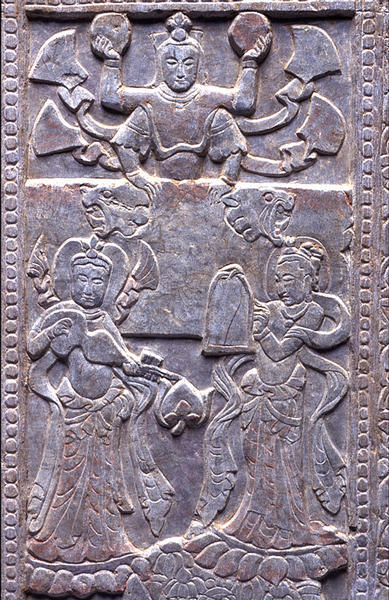
Nanaya (top) on a relief from the Miho funerary couch (Miho Museum; reproduced here for educational purposes only)
For the most part the evidence is limited to theophoric names, though. Due to unfamiliarity with Sogdian religious traditions and phonetic differences between the languages there was no consistent Chinese transcription of Nanaya’s name. I have no clue if Chinese contemporaries of the Sogdians were always aware of these elements in personal names referred to a deity. There is a fringe theory that Nanaya was referred to as Nantaihou (那那女主, “queen Nana”) in Chinese. However, the evidence is apparently not compelling, and as I understand the theory depends in no small part on the assertion that a hitherto unattested alternate reading of one of the signs was in use on the western frontiers of China in the early first millennium CE. The alleged Nantaihou is therefore most likely a misreading of a reference to a deceased unnamed empress dowager venerated through conventional ancestor worship, as opposed to Nanaya.
Among members of the Sogdian diaspora, in terms of popularity Nanaya was going head to head with Jesus and Buddha. The presence of the latter two reflected the adoption of, respectively, Manichaeism and Buddhism. Manicheans seemingly were not fond of Nanaya, though, and fragments of a polemic against her cult have been identified. It seems ceremonies focused on lamentations were the main issue for the Manichaeans. Sadly there doesn’t seem to be any worthwhile study of possible Mesopotamian influence on that - the only one I found is old and confuses Nanaya with Inanna.
We do not have much of an idea how Buddhists viewed Nanaya, though it is worth noting a number of other Sogdian deities were incorporated into the local form of Mahayana (unexpectedly, one of them was Zurvan). It has also been argued that a Buddhist figure, Vreshman (Vaisravana) was incorporated into Nanaya’s entourage.
Nanaya might additionally be depicted in a painting showing Buddha’s triumph over Mara from Dunhuang. Presumably her inclusion would reflect the well attested motif of local deities converting to Buddhism. It was a part of the Buddhist repertoire from the early days of this religion and can be found in virtually every area where this religion ever spread. Nanaya is once again in elevated company here, since other figures near her have been tentatively interpreted as Shiva, Vishnu, Kartikeya and… Zoroaster.
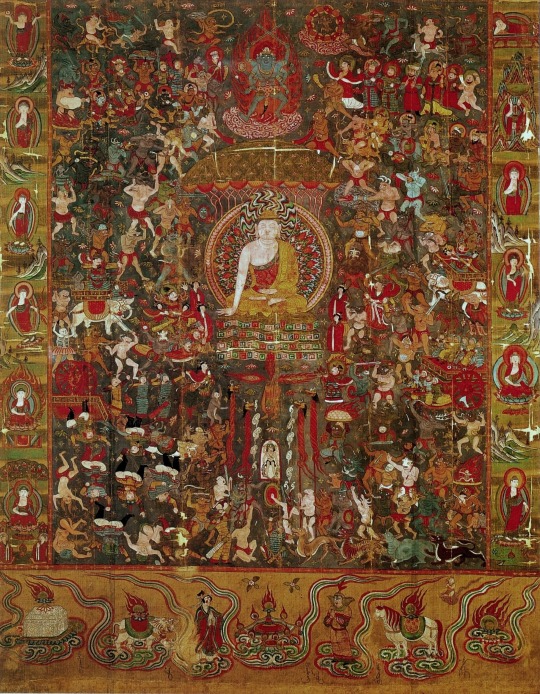
Buddha conquering Mara (maravijaya) on a painting from Dunhuang (wikimedia commons)

zoom in on a possible depiction of Nanaya next to a demon suspiciously similar to Tove Jansson’s Fillyjonk
To my best knowledge, the last absolutely certain attestation of Nanaya as an actively worshiped deity also comes from the western frontier of China. A painting from Dandan Oilik belonging to the artistic tradition of the kingdom of Khotan shows three deities from the Sogdian pantheon: the enigmatic Āδβāγ (“highest god”; interpreted as either Indra, Ahura Mazda or a combination of them both) on the left, Weshparkar (a later version of Kushan Oesho) on the right and Nanaya in the center. It dates to the ninth or tenth century.
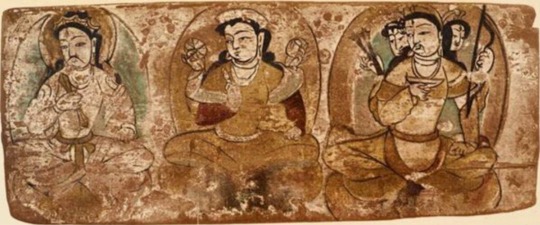
Nanaya (center) on the Dandan Oilik painting (wikimedia commons)
We will probably never know what Nanaya’s last days were like, though it is hard to imagine she retained much relevance with the gradual disappearance of Sogdian culture both in Sogdia and in China in the wake of, respectively, the rise of Islam in Central Asia and the An Lushan rebellion respectively. Her history ultimately most likely ended with a whimper rather than a bang.
Conclusions and reflections
Obviously, not everything about Nanaya could be covered in this article - there is enough material to warrant not one, but two wiki articles (and I don't even think they are extensive enough yet). I hope I did nonetheless manage to convey what matters: she was the single most enduring Mesopotamian deity who continued to be actually worshiped. She somehow outlived Enlil, Marduk, Nergal and even Inanna, and spread further than any of them ever did.
It does not seem like her persistence was caused by some uniquely transcendent quality, and more to a mix of factors we will never really fully understand and pure luck. She is a far cry from the imaginary everlasting universal goddesses such longevity was attributed to by many highly questionable authors in the past, from Frazer to Gimbutas. Quite the opposite, once you look into the texts focused on her she comes across as sort of pathetic. After all, most of them are effectively ancient purple prose.
And yet, this is precisely why I think Nanaya matters. To see how an author approaches her is basically a litmus test of trustworthiness - I wish I was kidding but this “Nanaya method” works every time. To even be able to study her history, let alone understand it properly, one has to cast away most of the dreadful trends which often hindered scholarship of ancient deities, and goddesses in particular, in the past. The interchangeability of goddesses; the Victorian mores and resulting notion that eroticism must be tied to fertility; the weird paradigms about languages neatly corresponding to religions; and many others. And if nothing else, this warrants keeping the memory of her 3000 years long history alive through scholarship (and, perhaps, some media appearances).
Bibliography
Julia M. Asher-Greve & Joan Goodnick Westenholz, Goddesses in Context: On Divine Powers, Roles, Relationships and Gender in Mesopotamian Textual and Visual Sources (2013)
Paul-Alain Beaulieu, The Pantheon of Uruk During the Neo-Babylonian Period (2003)
idem, Nabû and Apollo: The Two Faces of Seleucid Religious Policy in: Orient und Okzident in Hellenistischer Zeit (2014)
Matteo Compareti, Nana and Tish in Sogdiana (2017)
idem, The So-Called "Pelliot Chinois 4518.24". Illustrated Document from Dunhuang and Sino-Sogdian Iconographical Contacts (2021)
Olga Drewnowska-Rymarz, Mesopotamian Goddess Nanāja (2008)
Benjamin R. Foster, Before the Muses: an Anthology of Akkadian Literature (2005)
Andrew R. George & Manfred Krebernik, Two Remarkable Vocabularies: Amorite-Akkadian Bilinguals! (2022)
Valerie Hansen, Kageyama Etsuko & Yutaka Yoshida, The Impact of the Silk Road Trade on a Local Community: The Turfan Oasis, 500-800 in: Les sogdiens en Chine (2005)
Wilfred G. Lambert, Babylonian Creation Myths (2013)
Enrico Marcato, An Aramaic Incantation Bowl and the Fall of Hatra (2020)
Christa Müller-Kessler & Karlheinz Kessler, Spätbabylonische Gottheiten in spätantiken mandäischen Texten (1999)
Lilla Russel-Smith, Uygur Patronage in Dunhuang. Regional Art Centres on the Northern Silk Road in the Tenth and Eleventh Centuries (2005)
idem, The 'Sogdian Deities' Twenty Years on: A Reconsideration of a Small Painting from Dunhuang in: Buddhism in Central Asia II. Practices and Rituals, Visual and Material Transfer (2022)
Tonia M. Sharlach, An Ox of One's Own. Royal Wives and Religion at the Court of the Third Dynasty of Ur (2017)
Michael Shenkar, Intangible Spirits and Graven Images: The Iconography of Deities in the Pre-Islamic Iranian World (2014)
idem, The Religion and the Pantheon of the Sogdians (5th-8th Centuries CE) in Light of their Sociopolitical Structures (2017)
idem, The So-Called "Fravašis" and the "Heaven and Hell" Paintings, and the Cult of Nana in Panjikent (2022)
Marten Stol, Nanaja in: Reallexikon der Assyriologie, vol. 9 (1998)
Michael P. Streck & Nathan Wasserman, More Light on Nanāya (2013)
Aaron Tugendhaft, Gods on Clay: Ancient Near Eastern Scholarly Practices and the History of Religions in: Canonical Texts and Scholarly Practices. A Global Comparative Approach (2016)
Joan Goodnick Westenholz, Nanaya, Lady of Mystery in: Sumerian Gods and Their Representations (1997)
idem, Trading the Symbols of the Goddess Nanaya in: Religions and Trade. Religious Formation, Transformation and Cross-Cultural Exchange between East and West (2014)
Xinjiang Rong, The Colophon of the Manuscript of the Golden Light Sutra Excavated in Turfan and the Transmission of Zoroastrianism to Gaochang in: The Silk Road and Cultural Exchanges between East and West (2022)
Gioele Zisa, The Loss of Male Sexual Desire in Ancient Mesopotamia. ›Nīš Libbi‹ Therapies (2021)
#mesopotamian mythology#sumerian mythology#mythology#bactrian mythology#sogdian mythology#sogdia#nanaya
417 notes
·
View notes
Text
'Goodnight World' III

Summary: After the Aranara brings Aether to the World he finds out that The Creator is unable to wake up.
Note: Not proofread!
WC: 1.4k
MASTERLIST || PREVIOUS || NEXT


“So…” Paimon wonders out loud,
“Did you really think they were the Creator?”
“It sure seemed like it.” Aether answers dismissively.
The two had made their way out of Varanara a while ago. Without a boat to bring them back to Sumeru city, it had taken longer than the two had originally planned. And with this newfound extra time, Aether had been stuck in his head – his thoughts all revolving around the Creator.
Because.. if it really is what it seems, – he might be able to unravel Teyvat’s mysteries in one quick move.
And Aether wasn’t sure if he was ready for that.
“Ohh! Do you think we can get something to eat before we go to find Nahida?” Paimon hovers closer to Aether. Her small feet kick in the air with excitement after the thought of food.
Aether looks at the pixie with amusement. Somehow world problems never seem to bother her. For a good moment he has to stop himself from smiling at her unprompted need for food.
Instead of giving her the satisfaction of a smile, he lifts an eyebrow in a teasing manner,
“Are you really more interested in food rather than helping the Creator of Teyvat?”
A loud gasp is heard beside him. “Paimon didn’t say that!”
The pixie huffs and crosses her arms, all while continuing to float forwards. “Paimon is very curious, but it’s been so long since we last had anything else than boar meat.” She sulks.
“I’m sure we’ll have time to visit a city tavern while we’re there. But – I would really want to see Nahida before we do.”
“Paimon understands!”
Aether looks at his companion, urging her to continue.
“Well… Paimon thinks it has to do with your sibling right?”
Aether moves his eyes back in front of him. At the mention of his sibling, words die in his throat.
He chooses to nods silently.
“Then it’s settled!” Paimon giggles and throws her hands in the air. “First we’ll find Nahida, and then you’ll buy Paimon loooots of food!”
“As if I don’t normally buy your food.”
“Hmpf!”

Aether looks around him.
The two had finally arrived at their destination. And without much observation, Aether was able to notice that Sumeru city had gotten busier than before.
It seems that after the Dendro Archon got back in business, the citizens of Sumer have started to pick up a new daily routine. On one hand, with no sages left to guide them the scholars seemed to slow down their work in favour of waiting for a new one to take over. And on the other, new knowledge was shared without the old sages limiting things.
But, perhaps it was mostly due to the Akasha being shut down.
Aether notices a group of scholars carrying stacks of books in their arms.
Before, it had been effortless to get common knowledge. The Akasha would immediately bring it up for its user to see without them having to check in to lend books and whatnot. But now that they lost that, they had to manually search up knowledge relevant to their studies.
It would only be natural that the streets would get busier with scholars needing to find that knowledge.
And amongst these students there should be a young Archon wandering around.
Aether had already checked the Sanctuary of Surasthana, but she had been nowhere to be seen. Then, as he made his way to the Akademiya in hopes of asking the Acting Grand Sage about Nahida, he heard scholars talking about the very Archon he was searching for.
So somewhere nearby, –
“Nahida, Nahida!”
Paimon waves her hand with excitement when she sees the young Archon appear from the crowd.
The Dendro Archon already seems to have noticed both and Aether can see Nahida smile as she comes closer.
“Hmm? Paimon and the Traveller?” She laughs for a moment, “I didn’t expect to see you here so soon. Have you been enjoying your travels?”
“Yes! – uhh… No?”
Paimon puts her hands to her head in confusion. She sends Aether a look before visibly deflating, “Ugh… Paimon doesn’t know anymore.”
The Archon looks between the two with curiosity. “Did something happen? You seem… stressed perhaps?”
As always, Nahida seems to be able to sense that something is off. Yet it worries Aether that the Young Archon had never mentioned the Creator before.
Does she really not know…?
Paimon whines, “Yes, something is probably wrong. That’s why we wanted to talk to you.”
“Oh?” Nahida turns her head to the side in a curious manner.
“You see…”
Paimon turns to Aether for help. Within a few words he’s able to summarise the whole problem; “We saw the Creator.”
Nahida makes a weird expression. It starts with something similar to shock which then turns into confusion.
For a moment it’s silent. When Aether looks down at the Archon he can see her thinking about his words. Her hand is holding her chin and her eyebrows are slightly furrowed.
“Paimon will explain! When we visited Varanara, an Aranara led us to this giant open space underground and we saw the Creator asleep!” The little pixie floats wildly in the air as she makes gestures with her hands and puts emphasis on her words.
“They even talked to us in our minds!”
Nahida lets out a warm laugh after that.
Her eyes close and she seems to be genuinely enjoying the moment.
“I must say. Your jokes have elevated in a way I could not predict them anymore. For a moment I thought you actually met the Creator.”
A small giggle escapes her lips again before she continues, “It would be a funny joke if I wasn’t one of the few people still alive to have born witness to Their Grace’s disappearance.” The smile on Nahida’s face remains. It’s evident she thinks about the Creator in a positive light.
Aether furrows his eyebrows together. Wouldn’t Nahida have been born after the Creator’s disappearance? While he can’t fully confirm it, he assumes this must be Irminsul filling in the hole that’s been left behind after Nahida removed Rukkhadevata from Teyvat.
Nahida puts a hand to her chest in a solemn way. “To be completely honest, the Creator’s disappearance was something none of the Archons had suspected to be possible. The Creator of Teyvat, – leaving its world to fend on its own.”
“For as long as the Cataclysm of 500 years ago lasted, we believed it would be the end of an era. The end of Teyvat.” Nahida lets her arms dangle next to her sides again. While she’s obviously fond of the Creator, these thoughts seem to bring up bad memories as well.
Paimon looks between Aether and Nahida. “But…”
The traveller fills in the words in his head; if The Creator is truely gone, who did we see?
As the pixie trails off, Nahida continues. “If the Creator truly was in Sumeru, I would’ve known. But the last time I checked Irminsul, all traces of the Creator were broken off 500 years ago. Right after the cataclysm spread over Teyvat.”
Aether thinks for a moment.
As an outlander he’s the only one here not affected by Irminsul. Could it be that someone or something removed the Creator’s existence from the tree 500 years ago for some reason?
Perhaps he should find out why the Creator disappeared that long ago…
“What if someone did find the Creator?”
“Then you’d save the world.” Nahida replies to Aether without missing a beat
“When the Creator left, they left behind many unstable energies that would cause a catastrophe later on, such as leylines. Adventurers might be able to fight the effects of these unstable energies, but it’d eventually take its toll on Teyvat. I’m sure this is something many Archons and citizens alike have thought about.”
“But most importantly, Their Grace will be able to cast light in the dark. Hope where people feel lost.”
“After all, fear is rarely a good adviser.”
Aether shares a look with Paimon before returning his attention to Nahida. Her green eyes seem to be filled with joy at the mere thought of the Creator returning.
“Aether, if it were truly the Creator you saw, then you might restore Teyvat as it once was.”

#sagau#aranara#genshin x reader#sagau cult au#sagau x reader#sagau isekai#sagau aether#multiple choice#aether#aether x reader#genshin#genshin impact x reader#genshin impact#genshin drabbles#genshin imagine#sagau genshin#genshin aranara#nahida#paimon
1K notes
·
View notes
Note
Hi I saw your requests are open you don’t have to write anything if you don’t want to but I had this idea and I wanted to share
I was thinking of meting Charles on Monaco maybe during Sumer break or something, and being a little homesick so he decides to take us to a bookstore (sorry I just like to rad a lot you can change the place) and just talking about like a book he likes and just sitting on the floor with him looking for something to read and getting romantic
Idk if it makes sense but thank you and have a nice day/night
Home is Where You Are
Charles leclerc x reader
Genre: fluff
Request: Yes! I hope you enjoy it, I thought the idea was super cute! I'm open for Max, Charles, Lando, Oscar, George, and Daniel. Also, up for poly fics if anyone is interested. (If you have too much love to go around, clap your hands)
Summary: living with Charles is a dream come true. Longing for home, though, can strike anyone. Good thing he's there to help you through it until you can find time to go visit.
Warnings: home sickness, straight fluff
Notes: written in second person. Likes, comments, and reblogs are always appreciated!
Also, I've sent up my account to let tips be enabled. I was debating whether or not to say this because i dont want to sound like im begging, but frankly, people opinions do not matter me me. If you like my writing and want to support me, please consider tipping my posts or my blog. I put a lot of effort into my writing, and it would mean the world to me. Obviously, I won't have my feelings hurt if you ignor this, but I wanted to put it out there.
Masterlist

You and Charles had been together for a while now. Managing to do some long distance when you couldn't travel with him.
Now you were engaged, and you said yes. Knowing you wanted to spend the rest of your life with him.
You traveled more now. Finding yourself in different countries for the majority of the year. But you always went back home when you could. The family and familiarity bringing you comfort.
When Charles asked you to move in with him, you'd been happy. The two of you now completely together. Ready to share your lives with each other.
You were lucky you could take your job anywhere. The traveling often helping provide inspiration for your novel.
Charles made sure you felt comfortable in his, now yours as well, apartment. Making sure you had your favorite foods. He purchased an entire bookshelf just for you. He even stockpiled the apartment with soft blanket.
It was a dream come true for you.
You loved it. Waking up with Charles. Eating breakfast with him. Not having to FaceTime him to say goodnight for half the year.
When the summer break for formula 1 came around, you found yourself wanting to go back to your home country. You'd been back in Monaco for less than a week, but the days had you missing things you didn't realize you would.
You liked it in Monaco. It's your home now. But it didn't stop your mind from wandering back to the streets you grew up on. To your friends and family. The shops you frequented.
That's how Charles found you. Sitting at the table, staring into your cup of tea. Lost in the world of your subconscious.
"Mon Amour? Are you alright?"
His voice dragged out out of your thoughts. Your eyes dragging themselves to his face as he found a spot next to you.
He knew something was wrong. There was really no point in trying to lie when it was written all over your body.
You run your finger around the rim of your glass. Taking comfort in Charles nimble fingers running up and down your arm.
"Just a bit homesick, I guess." You confessed. Sighing at your relentless thoughts. Pulling your heart deeper into its sad state.
Charles hums in response. Considering what you'd said to him. "I think I know how to cheer you up." He smirks.
Charles couldn't take you back to your home country currently. You'd been working ridiculously hard, and he'd been busy doing sim work. He'd get you there soon, but for now, he'd settle for trying to get your mind off things.
An hour later, you were dressed and walking down the streets of Monaco. Nonclue where Charles was taking you. Just giggling as he held your hand and pulled you along with him. The two of you are making conversation about anything that pops into your heads.
Charles was basking in the warmth of your smile. So much so that he almost missed his intended destination. A little corner store with a vintage looking sign reading 'Nook's Books'.
"Here we are." He smiled and opened the door for you. A little bell rang to alert the owner that someone had entered.
Charles watched as your mouth opened in awe. Taking in the shelves lined top to bottom with books new and old. "I thought you might like it."
"Why did I never know about this?"
"It's hidden away, so those who don't know the city will have a harder time finding it. It's our own little corner of peace." He rubbed the back of his neck sheepishly. "I was going to surprise you right before the wedding."
It didn't take long for you to grab Charles' hand and lead him down the rows of books.
You'd found many books that you liked and had picked a spot on the floor to look through them.
Charles couldn't help but admire you. On the floor surrounded by books. You looked adorable in his eyes.
He plopped down next to you and spread out his arms and legs. Inviting you without words to come rest your body against his. You happy oblige. Crawling into the safety of his arms.
You spent hours in the small store. Charles listening intently as you either talked about a book or read chapters from one.
The twobof you finally left when the store was about to close. Having spent so much time there that it was now dark outside. The streets illuminated with the orangey hue of lampposts.
Charles spun you around as you walked, Making you giggle. Completely unbothered by the nightlife of Monaco.
When you two made it to the outside of the apartment building, Charles pulled you into him.
"I know I can't get you back to your family right now, but are you feeling a bit better?"
"Yes, thank you, for everything." Your eyes met his soft gaze.
"No thanks needed. I was simply doing my job." He chuckled. Leaning in closer to you.
Finally, his lips landed on yours. A loving kiss shared between you two. But this time, when he kissed you, you knew Charles was your home.
#x reader#fanficion#f1 fic#formula one#formula 1#racing#fluff#reader is a reader#charles leclerc x you#charles leclerc x reader#charles leclerc fic#charles leclerc#charles#leclerc#charles leclerc x girlfriend!reader#charles leclerc x y/n#ferrari racing#ferrari formula one#scuderia ferrari#ferrari#formula racing#f1#cl16#cl16 x reader#charles leclerc imagine#charles lechair#charles leclerc is a simp and you can't change my mind#hes so adorable#Monaco#motorsport
291 notes
·
View notes
Text

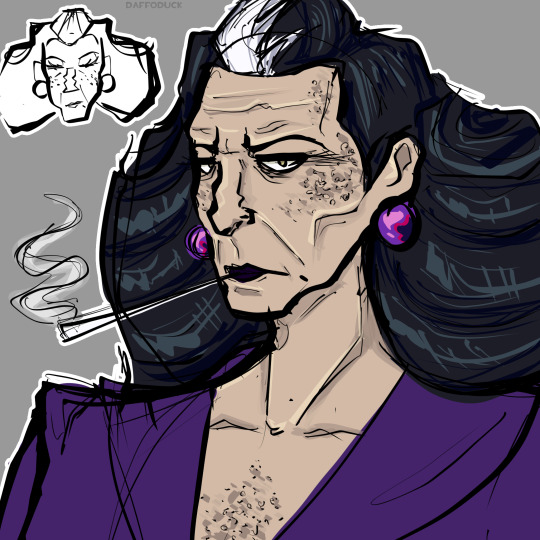

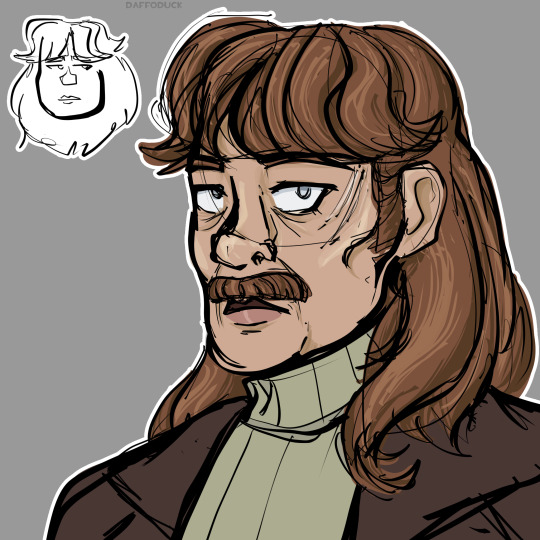


Bunch of two fort ladies hell yeah B)
headcannons of inconsistent length below the cut
Zhanna: reeeeeeoow!!! She’s so gorgoryse . gay as hell about all these women tbh. Yeah I just gave her body hair and thicker eyebrows because it’s cool as fuck. And a bear claw scar from when she tried to take home a baby bear when she was little. I think she really likes bears and wants one as a pet. Maybe the bear and soldier’s raccoons would get along aww <33
Admin:
yipppeee evil old lady!!!!! . Gave her acne scars , think she would pick her face when she was younger and the scars never faded. shes so pretty heruhghhsg. She smokes these fucked up super long cigarettes idk. I like her wonky nose, maybe she got into a fight or something and broke it.
Scouts Ma:
oh man I have so many ideas for her hehehhe. Okay so her name is Jenny, shes Puerto Rican, moved to Boston when she was a young adult, and she’s around the same height as sniper. She’s green because she’s both the scouts mother, and I didn’t want her to be purple like Pauling and Admin I wanted her to be her own person.
Her heart locket contains a bunch of pictures of her boys that all cartoonishly fold out to the floor when she opens it up.
She’s bi and poly, and currently dating both the spies because I think it’s funny. I can’t decide if both the spies would also be dating each other or would hate each other, maybe it depends on the time of day. Oh also she used to be an assassin! Maybe that’s why she had to move because she got found out at her old hometown. Anybody who got too rough with her boys were never seen again, only reason the scouts made it out alive lol.
She’s only recently gotten back together with the spies, had a falling out with Red before she knew she was pregnant, but he wanted to reconnect with her after finding out Red scout was his kid. Blu and her were friends for a really long time, she was the surrogate mother to Blu scout, but they fell out of contact when Blu spy had to take scout and disappear due to some espionage work gone wrong. When both the Blus join the team, the red scout recognized them and Blu spy eventually reconnected with Jen through that.
All of her kids are out of the house and she’s retired, so she has a lot of free time. She hosts foreign exchange students and fosters baby animals. She does a lot of traveling and shopping, she also likes knife and axe throwing, while doing some abstract sculpting on the side.
Maggie:
I love Maggie she’s so interesting,, I really like the panels where she’s laughing with saxton on the plane. Oh yeah gave her a mustache cus she’s Australian!, don’t be shy give the pretty lady a mustache she deserves it. That line on her lip was from this one girl I had a crush on back in high school, she said that she was bullied for it. don’t think I’ve ever seen it on another person since. She was one of the most beautiful people I’ve ever met. I hope she’s doing alright. She was a really good friend, real wonderful person.
Merasmus:
hi Merasmus how r u. oh yeah I’m trying out some other designs for her because I’m working on a little animated series about her and a magic spell she fucks up. I want her to be Sumerian because Sumer is so interesting!! I’ve been learning about the art from it in class, check out the Sumerian virtue status or the Epic of Gilgamesh they’re some of my favorite bits of history we’ve learned so far. Oh yeah also I think when she takes off that weird cap thing she has the longest most beautiful curly hair that goes down to her ankles because I love those kind of visual gags hehe. Also yeah she has piercings idk why I did that. I think she’s kinda blind and she uses her skull to see with her magic or whatever. I love her facial expressions in the comics,, have you guys seen the cunty Merasmus poster i love the cunty Merasmus poster
Miss Pauling:
MISS PAULFIJF LETS FUCMIGN GOOOOOOOO!!!!!!!!!!!! She’s got sideburns because im a dyke bleh blehhhh . hshe look at her big ass glasses I’m in love. Oh yeah I gave her lots of moles! And changed up her sleeve colors. Too tired to write much more lol
#tf2 fanart#zhanna#tf2 administrator#scouts ma#tf2 maggie#merasmus#miss pauling#tf2 headcanons#daffys drawings
144 notes
·
View notes
Text
I'm not seeing enough deep-dive nonsense about the new Good Omens season 2 poster drop on my dash, and by god that means I must be the one to deliver it.
For those who haven't seen it yet, behold:
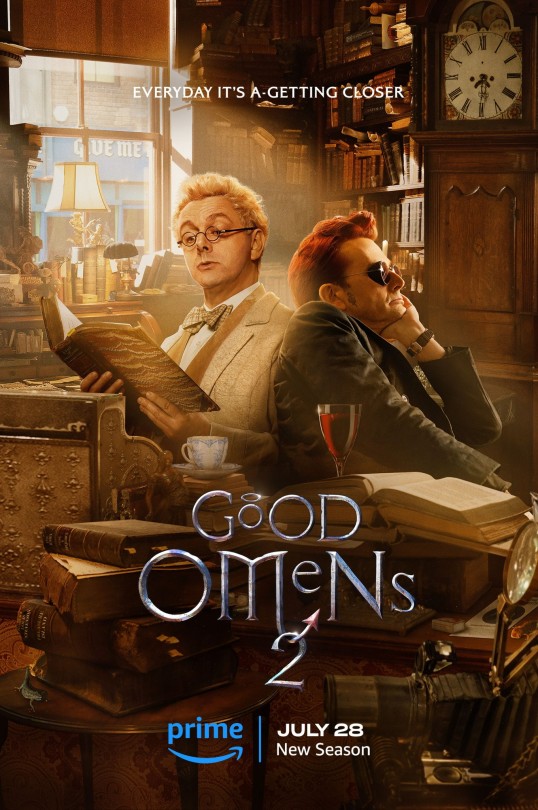
...there's a lot in here to go a wee bit feral over, if one was so inclined, and lord knows I love an inclination.
The Obvious Stuff
1. There Was Only One Bed Chair
This is the bulk of the commentary I've seen, and tbh, it's pretty great. "I am bored/busy and ignoring you but also what is personal space, never heard of her, we will not be taking questions at this time."
Notably, however, this is the second time we've seen them back to back-- the majority of the poster art we saw for the first season had them side by side. In both cases they're in a position to face some third thing together-- the difference, perhaps, is that side by side might imply equality of situation, while back to back implies implicit trust that the other won't stab you there.
2. The bookshop
Aw, look at them. Look at it. What a glorious little mess. This is them in London. Arizaphale looks pleased with the situation; Crowley looks bored af but he's also squished up on that one dang chair, so there's a "cat sitting next to you because parallel play and mirroring are the Best Interactions" feel to it.
3. Tea and wine
Arizaphale's got a teacup, Crowley's got a wine glass, this is very Them and indicative of their Vibes. Tbh, I think this is just a nice bit of design work, but it's worth calling out.
4. The outside street
The shop across the way is using a Gothic and reads "GIVE ME" before being cut off. No clue what it means, but it probably means something.
5. The tagline
The previous tagline we got was "Something's going down in the Up" (with that grey feather falling between their black and white wings)-- this tagline reads "Everyday it's a-getting closer."
Easiest interpretation is, oho, we're getting closer to the second season, and gosh there will be some Plot in it. And sure, yes, it works for that too, huzzah. But leaving aside the "it" and what that may mean-- "a-getting" is a fascinating word choice. It evokes similar constructions like, say, the somewhat obscure "Sumer is icumen in" (a song about the changing of the seasons and also encouraging a cuckoo to go lay some eggs in other birds nests if u no wat im sayin eyyyyy)-- and the significantly less obscure protest song "The Times They Are A-Changin'", whose ending stanza is:
The line it is drawn
The curse it is cast
The slow one now
Will later be fast
As the present now
Will later be past
The order is rapidly fadin'
And the first one now
Will later be last
For the times they are a-changin'
Gosh.
Now the Real Fun Starts
This poster is a composite image (as so many ads are), composed of different bits and pieces to form a whole impression -- based on fun stuff like relative pixelation and whatnot, you can often tell what portions of an image were there to start with, and what were specifically added in after the fact. How packed this poster is in tiny details -- which is exactly where I would hide fun hints to things -- is generally a cue for me to take a closer look, and I have been, I think, rewarded.
1. The books with legible titles
Zoom in on Aziraphale's book-- he's reading Charles Dickens's A Tale of Two Cities. The "two cities" in play are Paris and London, and the book is set before and during the French Revolution.
It's the story of a man who had been previously imprisoned in the Bastille for 18 years, and then was released to go live with his daughter -- who he has never met, what with the whole "imprisoned" thing -- in London.
The opening paragraph is:
It was the best of times, it was the worst of times, it was the age of wisdom, it was the age of foolishness, it was the epoch of belief, it was the epoch of incredulity, it was the season of Light, it was the season of Darkness, it was the spring of hope, it was the winter of despair, we had everything before us, we had nothing before us, we were all going direct to Heaven, we were all going direct the other way – in short, the period was so far like the present period, that some of its noisiest authorities insisted on its being received, for good or for evil, in the superlative degree of comparison only.
The pile of books in the foreground have two visible titles: the topmost one is Jane Austen's Pride and Prejudice (a "novel of manners" that's considered a heavy-hitting romantic classic, and also yes the leads are both prideful and prejudiced and it takes an entire book for them to clear that up) and Robert Louis Stevenson's Treasure Island (a young adult coming-of-age adventure story about a kid who finds himself on an adventure with a bunch of pirates to discover buried treasure).
Of note: A Tale of Two Cities, Pride and Prejudice, and Treasure Island also all have note tabs sticking out of them, and are the only books that have them. This is reminiscent of how Arizaphale studied and referenced Agnes Nutter's prophecies.
Some of the books beneath the window technically have titles, but they appear to be about as pixelated as the rest of that section, and so I suspect they're just part of the scenery.
Similarly, most of the books on the background shelves are like that as well, except:
Joseph Heller's Catch-22 (A satirical novel set in World War II; Wikipedia briefly explains that "the novel examines the absurdity of war and military life through the experiences of Yossarian and his cohorts, who attempt to maintain their sanity while fulfilling their service requirements so that they may return home." The book also coined the phrase "catch-22," which is a situation someone can't escape because of paradoxical rules-- in the case of the book, you can't ask to be evaluated for insanity so that you can be exempt from flying dangerous missions, because "anyone who wants to get out of combat duty isn't really crazy.")
Iain Banks's The Crow Road (and a first edition, perhaps? I haven't read it, but apparently it's a Scottish family drama about a perfect murder against the backdrop of the 1990s Gulf War. Its opening line is "It was the day my grandmother exploded." The phrase "the crow road" is a euphemism, in the book, for death.)
Joseph Conrad's Lord Jim (Sparknotes says it's "the story of a man named Marlow's struggle to tell and to understand the life story of a man named Jim" -- a young man who goes to sea, makes a terrible and cowardly decision while following his leaders, and then spends the rest of his life haunted by it.)
There's at least one extra, partially obscured title:
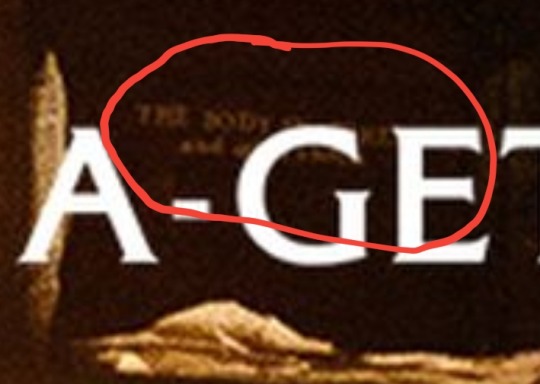
It appears to read "THE BODY ------ and ------", which makes me wonder if it's an anthology of murder mystery short stories.
Leaving aside the uncertain book, commonalities between many of these books include:
soldiers, war, and the horrors/absurdities thereof
doubles and parallels
death and murder
a young/inexperienced protagonist thrown in with more experienced/weirder folk
fragmented and out of order narratives, sometimes having to be pieced together from multiple viewpoints
...pirates
2. The strange but noticeable inserts
There are several images that have been inserted into the poster that -- unlike the teacup and wine glass mentioned above -- don't seem to make a lot of contextual sense and are therefore, perhaps, extra information. These include:
a. the three lizard boys
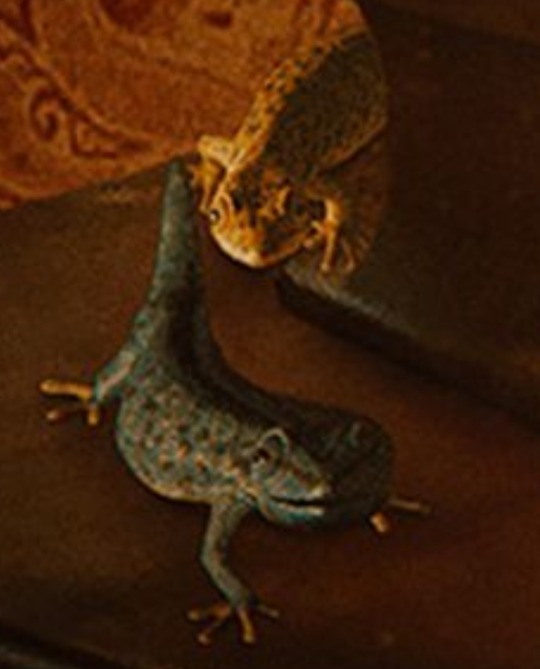
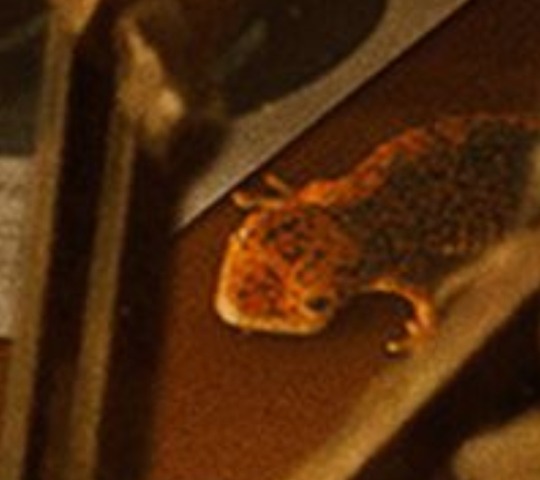
b. the broken smartphone
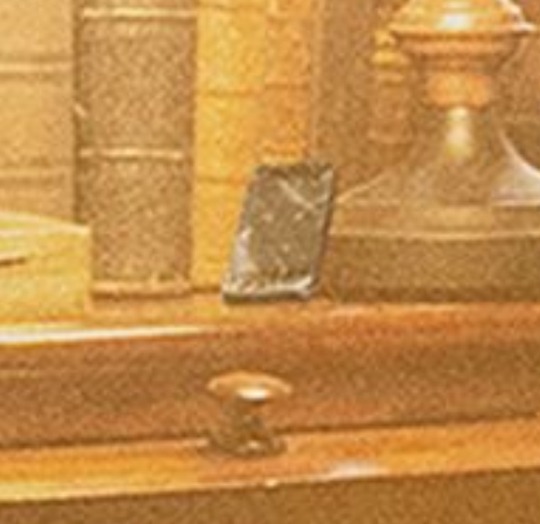
c. the matchbox with the quote on the side

d. the camera

e. this statuette that seems suspicious
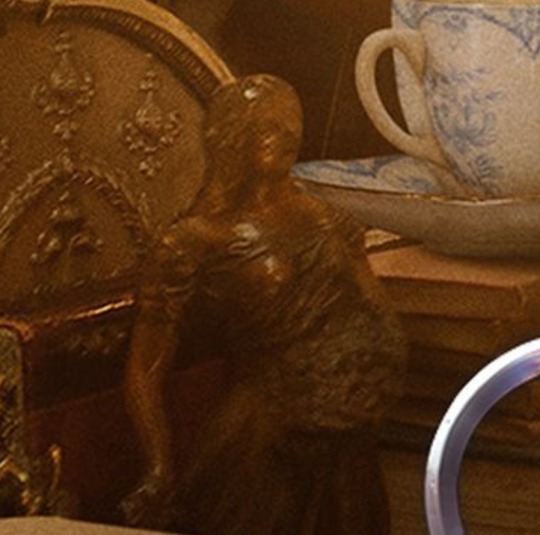
f. this record and scroll that seem out of place
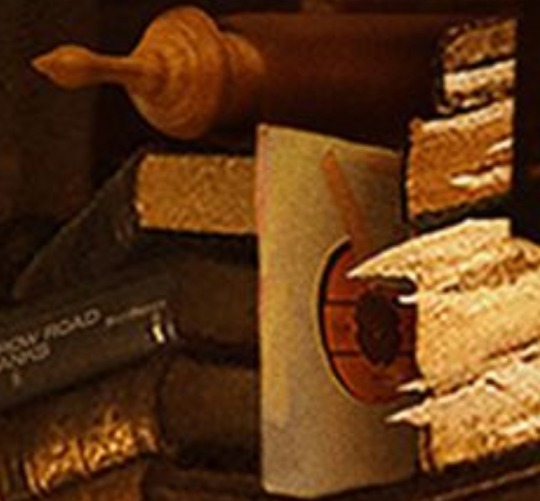
g. the clockface with the missing hand (which may be just for the Aesthetic, but whatever, I'm including it)

What do they mean? No clue. I suspect it will become apparent as we get trailers and/or the actual show.
In Conclusion
Uh.
Look. Design teams can do all sorts of things for all sorts of reasons. All of this could mean absolutely nothing.
But.
Using my magical powers of bullshit deduction, I might look at all this, and that grey feather falling from the earlier poster, and say... well... the war's still ongoing, yeah? So maybe... maybe there needs to be a new angel keeping an eye on things on Earth. Or an eye specifically on Aziraphale and Crowley.
And that would look SUSPICIOUS, right? So this is an angel who's maybe... a little bit Fallen. For the sake of the Mission. Like, they've agreed to sin just a lil bit, just enough to justify being thrown out of Heaven, and they're not actively in Hell because they're, oh, just stopping off, or maybe just going really slowly, or maybe they were sent back up from Hell because they were still "too good" and all that Pureness of Spirit was stinking up the place--
Whatever. Point is, they're on Earth, they're very confused, it sure would be nice if these very Established metaphysical elders could give them a few hints about how to get on. We'd then get to enjoy a Guide to Living a Totally Normal Human Life given by these two disaster dorks, plus whatever nonsense is derived from, idk, various extraneous plot shenanigans, probably involving a Murder and maybe a MacGuffin Maltese Falcon.
And most importantly: this new angel? Wow no they couldn't possibly be a spy because again WOW, what kind of angel would deliberately Fall? Wouldn't that require doing the wrong thing to do a right thing? ...okay maybe, but can it really be wrong if it was done by command? ...well, wait, it surely must be wrong because otherwise the mechanism wouldn't have worked-- but then, wait, which thing was the wrong thing--
And Aziraphale and Crowley would watch this bouncing volley of cognitive dissonance with great interest, also possibly while holding hands.
148 notes
·
View notes
Note
Could you do a sun centered outfit with sumer/springtime vibe? Could you also make it more masc (I'm fine with skirts tho) I really love ur blog <33
Sure!! It came out with a lot of primary colors, very summery in my opinion (even if it has pants and not something shorter for warm weather). I hope you like it!


#sunnycore#age regression#age regressor#agere#agereg#agere outfits#sfw agere#sfw regression#age dreaming#agedre#masc
178 notes
·
View notes
Note
what's with the purple lipstick or whatever it is of Abel's?
It's a combination of three things.
The most important thing is that when he was making his design, something on his face seemed off, and adding the purple lipstick made the whole design come together, purple specifically to make it stand out and not turn to blue so abruptly.
The second is a small nod to the fact that lipstick was used in Sumer, which was mostly semi-precious gems that were applied to the lips.
Third, I like to draw Cupid's bow
Next time you can ask in @entomo-maniac, as is my main blog, hope that helps
10 notes
·
View notes
Note
hello! i saw that requests were open and decided to take a shot at those. may i request some headcanons of tfp bumblebee and/or ratchet x gender neutral reader? they can be angsty or smutty, i don’t mind either of those. thank you for your writing! <3
Ofc!! Now writing bumble bee is a little hard to work with (for me personally) but I’ll try my best!(and I’ll try my best with a Gn reader!)
Characters included: tfp Ratchet , tfp bumble bee
Warnings: smut, angst, mention of death
Contains: smut (ratchet) , angst (bumble bee)
Bumblebee

Since he can’t talk to you he doesn’t know how to show you love
He often overthinks his love for you because he’s scared you could get hurt and he doesn’t want to lose you
Sometimes he distances himself from you because he doesn’t know what to do
Once he distanced himself so far from you that you followed him while he went on patrol
And he didn’t know you were following him and a decepticon had snatched you from him
They bribed Optimus and the others to get you back , when they came and got you something bee never imagined happened
One of the cons had stabbed a sharp object through your torso
And you eventually passed away
Bee was so heartbroken that he lost himself that day
He eventually locked himself in his berthroom and took his own life to try and be with you
Ratchet

Some afternoons he’ll be grumpy and tired but not for you
He loves just pounding into you as your wearing a Sumer dress on a hot day
He’ll reward you with some oral or fingering if you finish an assignment from ur university
He’s very gentle some nights but if he’s been in a mood he won’t be very gentle
He loves kissing you all over and giving you little hickies where other people or bots can see
When it’s just the two of you in the base, a good ol fashioned fuck on a desk in the med bay
If it’s your first time he’ll be very proud and gentle with you
He loves watching you go down on him
A couple of times he’d have to give you a wheel chair to use for a week
He’ll grunt in your ear from time to time
Now this was a hard one to do because I’m sick rn and I’m full of mucus and snot but I do really hope you enjoy this (it is my first time making this). But I really hope it’s decent enough to be good!!
25 notes
·
View notes
Text
Wolf and Stone - a scenario outline for Princess:the Hopeful
This scenario is doubly unfinished, partly because PtH scenarios need more tailoring to a specific group, and partly because I have never played the game. This is sort of an exercise in learning PtH, and possibly an opportunity for @brazenautomaton that some of the corrections/advice given to me in response might also be useful hints to add in the Storytelling chapter.
The basic scenario is that there's a plot device at the local museum, there's a werewolf pack that wants to get it, there's a director who is militarizing the museum, there's museum guides who are caught in the middle, and there's the Darkness making everything worse with fear so the involved parties won't communicate until the Magical Girls do some befriending.
-Context-
In whatever city the PCs live, the Modisett Ancient History Museum is a small, second-rate museum founded in 1924 by John Modisett, a veteran of the First World War. Its focus is on the Fertile Crescent region and the early cities of the Bronze Age around 2-3 millennia before Christ. The M.A.H.M. is primarily financed by the Modisett Estate Trust (which Modisett left his fortune to) and subsidised by the city's culture ministry.
Change details as necessary for your chronicle, naturally.
While the M.A.H.M. doesn't have particularly glamorous exhibits, it also doesn't have any nearby competitors for its niche. Regional schools send students touring it on a regular basis, seeing some ancient pottery, masonry, clay tablets, replicas of weapons that have been repatriated to an Iraqi museum, diagrams of ancient cities, political maps of Ancient Egypt, Akkad, Sumer, and Elam, and almost every year there's a teenage boy who thinks the most interesting thing is learning the word "phallus" from the statuette display.
-Trigger-
The M.A.H.M. recently acquired a new exhibit, presenting as a nested pair of ancient stone chests with false bottoms covered in cryptic markings. The informational plaque on the display says they were "likely used for ritual purposes". This is how archaeologists say "I don't know". These were in fact made to contain and bury some cursed mcguffin that the occultists of the time couldn't get rid of, and by opening the chests for display, the museum has once again allowed the curse to influence the world.
A nearby pack of werewolves were the first to notice. Their first attempt at dealing with it was straightforward: Visit the museum, as humans, and discreetly close the chests again. The museum guides propped the chests open in response. Now the pair of cursed chests are once again releasing (summoning? creating?) dark spirits and baleful influences on the world, and the werewolves are considering how to escalate. They fear discovery and retaliation and persecution if they breach the masquerade and explain the real facts of the matter, so they are trying to sabotage the museum, having a half-assed plan of stealing the chests while the M.A.H.M. is closed for repairs or while the exhibit is being transported to another museum.
(They are physically strong enough to carry it, but it would be extremely blatant having to smash the case and carry out a pair of large heavy stone chests.)
Matthew Brown, the director, is having none of it. He fears sabotage and loss of prestige and position, and enjoys the petty factoid that the M.A.H.M. did not shut down for the Second World War, it is certainly not shutting down for anything less. He has responded by militarizing the museum with police patrols, reducing opening hours, and worsening the experience for visitors in the name of security. This may be considered a minor case of the Darkness Ultimatum.
Abigail and Henry, the experienced museum guides, are caught in the middle. They fear losing their jobs if the museum shuts down, they also fear loss of visitor interest if the police keep harassing visitors, they're in denial about the supernatural, trying to pretend everything is normal or will go back to normal soon, and they fear that they're getting old and seeing things when they notice manifestations of the cursed chests. Abigail is an amateur historian herself, a voracious reader, and really likes her job and talking to visitors. Henry is more of a handyman and is the one tapped for repairs when someone has cut a power cord again.
-Hook-
If some or all of the Princesses are still in school, the easy way to get them involved is for their class to go on a field trip to the M.A.H.M. (Adult Princesses can buy tickets and come along with their friends.)
Here, a museumgoer might be attacked by a Ravenous Darkspawn (Princess chapter 5) taking the form of a toothed book. It's not going to kill anyone on the first strike, the victim can run away and there will be police nearby to shoot the beast eventually, but the Princesses may want to handle it first in a way that doesn't involve the police and lets them influence the reporting.
Otherwise, the nakama might hear about it because one of them, or one of their parents, is a friend of Abigail or Henry who are discreetly lamenting their situation and their paranoia and their worry that they're seeing things, and did you hear that one of the guests thought she was attacked by a book!?
-Monster of the Week-
Depending on how the nakama learns about and approaches the situation, it is likely to run into one of either the werewolves or an Insidious Darkspawn first.
The werewolves are likely to be found if the nakama traces the source of the mysterious sabotage incidents at the M.A.H.M. Shapeshifting and Gifts and Spirit proxies are good for evading the notice of mortal police, less so a fellow supernatural splat. There might be a fight as a result of the nakama finding saboteurs who refuse to be dissuaded by a polite request, and mutual boneheaded escalation, but it shouldn't be to the death. The werewolves aren't genuine antagonists, they're more like a party of PCs who have spent quite a bit of brainpower on "How do we best use our superpowers to sabotage the museum without getting caught?" with less attention paid to whether sabotage was actually a good idea in the first place. They can be talked down, more easily so if the Princesses have a good idea for what to do about the cursed chests and its dark spirits instead.
(I have not statted them in any detail because I really have not kept up with that particular splat in a while, and I have the impression they are one of the most varies-by-GM splats.)
The Insidious is likely to be found if the nakama gets nosy at the museum itself. It pretends to be a CIA agent (see below), flashing an important-looking badge, telling museumgoers they saw nothing, telling the police to suppress the ludicrous rumor about a biting book, ordering the Princesses to go home or it'll call their parents.
America Note: The FBI handles domestic matters, the CIA foreign matters.
If playing in America, anyone going "don't you mean FBI?" counts against the creature's Bane and exposes its fraud. Substitute other wrong agency as desired, possibly wrong jurisdiction, wrong country, or perhaps it's waving the ID of a thaumaturgical organization while telling people there's no such thing as magic. The critter didn't put thought into its disguise, it's formed from abstract fears manifested by the Darkness. Thus it might take on the appearance of a more famous organization, even if that's not the correct one for the situation. Still, a badge from a famous organization is effective on bystanders looking to avoid trouble.
-The Chests-
The dark curse spirit thingy is able to affect the world and reach out of the nested chests while they're open, but it's still too stuck there to leave. If you could close the chests and keep them closed, one inside the other, that would solve the problem. At least until someone opened them again. Some other ways Princesses could resolve the situation include:
Magic Ward Charm. The Darkness here is weak, threatening mostly because it can build up (or bleed through) to spawn monsters over time. The penalty from a Magic Ward is enough to suppress it, as long as the Ward remains undisturbed. Everyday Ward helps with this, or perhaps explaining the situation to the museum.
Blow up the chests, setting the dark curse spirit loose, then blow up that too. The ancient occultists sealed it away because they couldn't blow it up hard enough, but they didn't know how to weaponize the Inner Light as GIGADRIVE EXCEED BUSTER! The director will have questions about why Magical Girls are blowing up his museum piece.
Decipher the markings on the false bottoms with an appropriately difficult Academics roll, describing the gribbly in detail. Report it to your Queen, and she'll tell you how to exorcise that specific flavor of gribbly and seal the chests for good. Alternatively, the markings make explicit the fact that GIGADRIVE EXCEED BUSTER! is sufficient as above.
Get the chests out of the museum yourself, somehow, and hand them over to the werewolves to perform Captain Planeteer Exorcism. You'll get the chests back in a few days.
And with that, you can be done, if all you want is a monster of the week and a threat to the Modisett Ancient History Museum.
-Escalation Options-
An Insidious or Traitorous Darkspawn is whispering in the ear of Director Brown, who keeps escalating security while the werewolves are escalating their supernatural sabotage.
Director Brown becomes a Defiler himself, with relevant Dread Powers to compel unreasonable amounts of funding and mandatory attendance and city advertisements for the museum and his own self-aggrandizement.
The M.A.H.M. shuts down, and Abigail or Henry suffer a Breaking Point and become the Prisoner of a Nightscape revolving around the psychodrama of "If I had done better, I would still have my old job" and scenes of patching up sabotage, covering up rumors, playing nice with guests, denying that anything is wrong, while increasing amounts of museum destruction and darkspawn attacks happen in the background.
7 notes
·
View notes
Note
Hi there, I’m struggling to find direct translations seem to always be “romanised or Akkadian part versions of terms. I’m after the word ALWAYS in original Sumer cuneiform. I was led to UD-KUR-SE / matima but I’m not sure if this is later and rooted in time. But also if it is correct only find the individual symbols or UD then KUR and SE which on their on have differing meanings so I would like the combined cuneiform written as a whole. It is always as in forever & eternal. Thank you all
Hello! The general word I know for "always, ever" in Sumerian is udmeda, written 𒌓𒈨𒁕 in cuneiform. There are other words like ulshe and darishe that more precisely mean "forever" - see this post for more.
Udkurshe, the word you're referring to, can mean "always" but only in the past, as in "I always used to...", and is written 𒌓𒉽𒂠; in a question, it can mean "at any time, ever", as in "did you ever... ?" The Akkadian word matīma is the equivalent of udkurshe, meaning "always" only in the past.
I'm not sure what you mean by "rooted in time", other than that udkurshe (and udmeda) are derived from the root word ud, which means "day" and is used in a number of time phrases in Sumerian. I hope that helps!
9 notes
·
View notes
Text
INFORMATION ABOUT THE KIDGE EVENT!!
Hello! I hope you are all doing ok! for the ones who doesn't know, im working in a kidge event! im today giving you informations about it! ( don't forget to reblog so more people are aware of the event !!! everyone cando something for it, no skills are required of course!)
First of all; it is going to be a sumer event! the themes are being chosen right now and discussed! ( You'll have the opportunity to chose some prompts! ) If you have any prompts in mind, I'll be glad to hear about them! reach me in the comments or dm me however you want! (I'll give you the prompts that have already been chosen in less than a week!)
Now, how long will the event last? I thought about a full month or at least two weeks. nothing is sure yet!
If you have any questions, don't hesitate to ask! I'll answere the best I can !
this event is for fun and to enjoy kidge in 2023! you can write headcanons, fanfictions, draw stuffs or a lot of other stuffs as long as it is kidge.
anyways, those are the informations I can give you yet! I really hope that a lot of people will be a part of that event!
take care!
post about the event at the hashtag #kidge spring event
( Also! Thanks to @s1lverpaladin that is helping me to organise the event! Go checks her account for amazing kidge content en more! 😙)

#kidge event#kidge spring event#reblog#share#voltron#kidge#voltron legendary defender#pidge#voltron pidge#keith voltron#pidge and keith#keith and pidge#voltron kidge#keith
22 notes
·
View notes
Text
This is another fic related to the preavious feel Free to read them first before reading this for better understanding the concept(i Will also sumerize the lore relevent to this fic so that it's not necesary to read the first ones)
So Yes, You are what can be called a chosen one from an entity and You took the powers of others so that they aren't hurt by them by using your time powers to erase their memories of ever having that ability.
So what if every person has a way of hiding their powers from others like an objects that resemblences their Power. Time Will be a victorian watch You will have around your neck while maybe fire will have matches and things like that
The thing about this so called objects is that they can't be destroyed and You still can use your powers if the objects isn't near You, but once You use them the objects Will dissapear for as long as You use your powers, then it returns when You finish your actions
But as spoken before, the more use them, the powerfull You get, and maybe You get the ability to erase memories from "normal ones" too
So talking about the yanderes. They trap You and they can't take your powers away. So as a need to escape, You strat working on using them and training them better until You can erase their memories of You
So You erase your existance from their mind and run away thinking You are safe now. You met someone else, fell in love and forgot about your past "lover" thinking that You are safe and that they don't remember You
Imagine waking up one day and You feel empty, like something is missing and You instantly try to touch You watch, only for it to be gone. You wake up flabbergasted and look around in a hurry, trying to find it
Slowly, your lover walks in , caring the clock, now, your lover doesn't know about your powers or that the clock is only a way to hide them
You get up and start walking to him, but he takes a step back, holding the clock away from you
"give it back" You say in a desperate voice
"no" he simply says and puts it in his pocket. He then grabs your hand and moves You closer to him
"You don't understand, i need it-" he cuts You off by putting a hand over your mouth
"No" he says again
But it wasn't his voice, and it wasn't a difrent tone, it was difrent from the voice You knew your lover had, it didn't belong to him. It belonged to someone else, someone You hoped that would remain in your past
He seems to read your toughts looking at your eyes
"You know love, just because You erased my memories, it doesn't mean i can't get them back"
You try to brake away from his grasp but he holds You tigheter to him
"Don't You understand? You're mine" they say and then break your clock to pieces
He watches as it rebuilds itself around your neck and then he pulls You by it
"What did You do to my lover?!" You scream, voice shaky
He plays with the clock and then looks at You with a mocking look
"i forgot"
#moriarty the patriot#moriarty the patriot x reader#william james moriarty#louis james moriarty#yuukoku no moriarty#yuukoku no moriarty x reader#louis james moriarty x reader#mtp x you#william james moriarty x reader#Mtp#mtp mycroft#mtp x reader#mtp sherlock#Sherlock holmes#yandere moriarty the patriot#Yandere mtp#Yandere bungou stray dogs#Yandere bsd#fyodor dostoevsky x reader#bsd dazai#dazai x reader#Bsd jouno#Jouno x reader#bsd shibusawa#Shibusawa x reader#albert james moriarty x reader#Mtp John Watson#yuumori#mycroft holmes x reader#Billy the kid x reader
16 notes
·
View notes